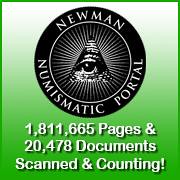
About UsThe Numismatic Bibliomania Society is a non-profit organization devoted to the study and enjoyment of numismatic literature. For more information please see our web site at coinbooks.org SubscriptionsThose wishing to become new E-Sylum subscribers (or wishing to Unsubscribe) can go to the following web page link MembershipThere is a membership application available on the web site Membership Application To join, print the application and return it with your check to the address printed on the application. Print/Digital membership is $40 to addresses in the U.S., and $60 elsewhere. A digital-only membership is available for $25. For those without web access, write to: Terry White, Treasurer AsylumFor Asylum mailing address changes and other membership questions, contact Terry at this email address: terrywhite5475@yahoo.com SubmissionsTo submit items for publication in The E-Sylum, write to the Editor at this address: whomren@gmail.com BUY THE BOOK BEFORE THE COINSale Calendar
|
- WAYNE'S WORDS: THE E-SYLUM APRIL 29, 2018
- BRESSETT NAMED FIRST RED BOOK EDITOR EMERITUS
- 1792 SPECIAL EDITIONS NEARLY SOLD OUT
- NEW BOOK: ENGLISH SILVER CROWNS
- NEW BOOK: THE MEDALS OF FREDERICK WILLIAM II
- NEW BOOK: TAIWAN TELEPHONE TOKENS
- NEW BOOK: LOTS OF FAITH AND LOTS OF PENNIES
- BOOK REVIEW: CONFISCATION
- SCRIPOPHILY APRIL 2018 ISSUE PUBLISHED
- DAVID BAILEY (C1946-2018)
- JOHN PETT (1951-2018)
- R. TETTENHORST
- SAMPLE SLAB UPDATE NEWSLETTER ON NEWMAN PORTAL
- NEWMAN PORTAL SEARCH: WASHINGTON GRATE CENT
- 2018 HIGGINS NATIONAL BANK NOTE SEMINAR
- 2018 BOSTON MCA CONFERENCE UPDATE
- NOTES FROM E-SYLUM READERS: APRIL 29, 2018
- THE 2018 BROOKGREEN MEDAL
- VOCABULARY TERM: ADJUSTMENT MARKS
- JACOB "JACQUES" SCHULMAN (1849-1914)
- BOWERS ON THE GREAT COLLECTIONS CATALOGS
- THE BOOKS OF Q. DAVID BOWERS
- U.S. MINT SEEKS LEAD MEDALLIC ARTIST
- CHINESE BANKNOTE ENGRAVER MA RONG
- THE MEDIA'S RARE COIN OVERHYPE
- HOLABIRD AMERICANA MAY 2018 AUCTION SELECTIONS
- THE WORTHINGTON TEXAS TOKEN COLLECTION
- NUMISMATIC NUGGETS: APRIL 29, 2018
- ANCIENT COINAGE OF ARMENIA
- MAXENTIUS, FIGHTER FOR ROME
- WAYNE'S NUMISMATIC DIARY: APRIL 29, 2018
- MORE ON THE NEW EFFIGY OF QUEEN ELIZABETH II
- SOUTH AFRICA MINTS LATENT IMAGE MANDELA COIN
- FAKE COUNTERFEITING NEWS AFFECTS INDIAN COINS
- CIVILIAN CONSERVATION CORP CAMP TOKENS
- SAWYER’S NATIVE AMERICANS MEDALS INFO SOUGHT
- MOTHER AND DAUGHTER AT ODDS OVER HERO'S MEDALS
- IRANIAN PROTESTERS SPREAD MESSAGE ON BANKNOTES
- COMMUNITY CURRENCY: LAKE DISTRICT POUND
- IN OTHER NEWS: APRIL 29, 2018
Click here to access the complete archive
To comment or submit articles, reply to whomren@gmail.com
Content presented in The E-Sylum is not necessarily researched or independently fact-checked, and views expressed do not necessarily represent those of the Numismatic Bibliomania Society.
WAYNE'S WORDS: THE E-SYLUM APRIL 29, 2018
 New subscribers this week include: Steve Ott, PJ Potter, and Stephen Silvers. Welcome aboard! We now have 5,802 subscribers.
New subscribers this week include: Steve Ott, PJ Potter, and Stephen Silvers. Welcome aboard! We now have 5,802 subscribers.
Thank you for reading The E-Sylum. If you enjoy it, please send me the email addresses of friends you think may enjoy it as well and I'll send them a subscription. Contact me at whomren@gmail.com anytime regarding your subscription, or questions, comments or suggestions about our content.
This week we open with an announcement from Whitman Publishing, four new books and one review, a new periodical issue, and notes on three recently departed numismatists.
Other topics this week include Sample Slabs, seminars and conferences, the 2018 Brookgreen medal, Jacques Schulman, Dave Bowers and his books, auction selections, Civilian Conservation Corp. tokens, and community currency.
To learn more about the Editor Emeritus of the Red Book, English silver crowns, Taiwan telephone tokens, avian guano, the Washington Grate Cent, adjustment marks, the Waterford Water Cure, Texas tokens, the Limerick Besieged Halfpenny, and the Lake District Pound, read on. Have a great week, everyone!
Wayne Homren
Editor, The E-Sylum
BRESSETT NAMED FIRST RED BOOK EDITOR EMERITUS
Hobby Legend Is Honored in the New 2019 Edition
 Kenneth Bressett, longtime editor of the Guide Book of United States Coins (popularly known as the “Red Book”), has retired into Whitman Publishing’s newly created position of Editor Emeritus. The 2019
(72nd) edition of the Red Book, available now from booksellers and hobby shops nationwide, features a 10-page illustrated tribute to Bressett. In addition, the hardcover format includes a commemorative gold-foil portrait and
a facsimile of his famous signature on the back cover. Bressett will make appearances at several shows and events throughout the year to autograph books.
Kenneth Bressett, longtime editor of the Guide Book of United States Coins (popularly known as the “Red Book”), has retired into Whitman Publishing’s newly created position of Editor Emeritus. The 2019
(72nd) edition of the Red Book, available now from booksellers and hobby shops nationwide, features a 10-page illustrated tribute to Bressett. In addition, the hardcover format includes a commemorative gold-foil portrait and
a facsimile of his famous signature on the back cover. Bressett will make appearances at several shows and events throughout the year to autograph books.
The Guide Book of United States Coins debuted in November 1946 (with a cover date of 1947) as the hobby’s only fully illustrated catalog with objective retail pricing for every U.S. coin. Prior to this, the Handbook of United States Coins (the “Blue Book,” first published in 1942) gave unbiased wholesale pricing—how much dealers were paying, on average, for U.S. coins. These two resources were both created by R.S. Yeoman and published by Whitman. Before them, collectors had to rely on lists written by individual coin dealers, which were seen as biased and did not have wide distribution. The first edition of the Red Book was so popular that it sold out 9,000 copies in a matter of weeks, requiring another print run in February 1947.
Kenneth Bressett, a young collector from Keene, New Hampshire, first met R.S. Yeoman at a coin convention in the mid-1950s. He mentioned several errors he’d found in the latest edition of the book. In 1956 Yeoman invited Bressett to be a freelance editor, and in 1959 Bressett moved with his family to Racine, Wisconsin, to officially join the Whitman Publishing staff full time. He worked closely with Yeoman—by that time one of the most famous numismatists in the world—developing the Red Book and Blue Book and many other hobby references and products. By the time Yeoman retired in 1970, Bressett had taken over many duties as “coordinating editor” of the Red Book. In the 27th edition he was credited as the book’s editor, and in the 66th edition he was elevated to Senior Editor, with Q. David Bowers and Jeff Garrett assisting as Research Editor and Valuations Editor, respectively.
Now, in 2018, after nearly 65 years of work on the Red Book, Ken Bressett is being promoted again, this time to the position of Editor Emeritus. Garrett is taking the reins as Senior Editor and Bowers is continuing as Research Editor. “Although Ken will step down from day-to-day management of the Red Book, we know his work in numismatics will continue,” said Whitman publisher Dennis Tucker. “And of course his influence, like that of R.S. Yeoman, will be felt for as long as the book is enjoyed by hobbyists around the world.”

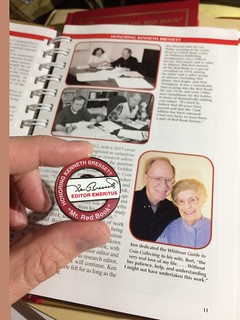
Tucker encourages collectors to buy two copies of the hardcover this year—one for day-to-day use, and one to have Bressett autograph as a numismatic keepsake. “Mr. Red Book” will be at the American Numismatic Association Summer Seminar in Colorado Springs, June 16–28, and the ANA World’s Fair of Money in Philadelphia, August 14–18. He is scheduled to appear for a week of celebrations at the Whitman Coin and Collectibles 2018 Winter Expo, October 25–28.
“The story of the Guide Book of United States Coins is not merely a story about those who produced it,” Bressett has said. “It is a tribute to the thousands of individual contributors who have honed its contents to the point that it has become a numismatic standard and a valuable collectible in its own right. It is a success story that remains unparalleled by any other numismatic book.”
To read the earlier E-Sylum article, see:
NEW BOOK: 2019 GUIDE BOOK OF U.S. COINS (http://www.coinbooks.org/v21/esylum_v21n10a02.html)
THE BOOK BAZARRE
1792 SPECIAL EDITIONS NEARLY SOLD OUT
1792: BIRTH OF A NATION’S COINAGE
SPECIAL EDITIONS ALMOST SOLD OUT
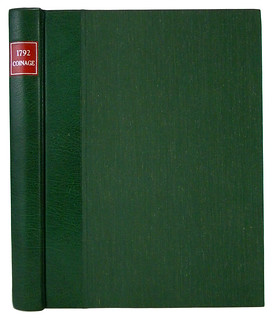

Kolbe & Fanning Numismatic Booksellers have announced that the special deluxe edition produced for last year’s NLG Book of the Year winner 1792: Birth of a Nation’s Coinage, written by Pete Smith, Joel J. Orosz, and Leonard Augsburger, is nearly sold out.
Thirty copies of the book were hand-bound in green quarter morocco with Japanese cloth sides. The high quality of the leather used, in combination with the luxurious feel of the Japanese cloth, make this an unusually pleasing special edition. Twenty-five copies were reserved for sale, and only a few copies remain. They can be ordered from the Kolbe & Fanning website for $325 at: numislit.com/pages/books/4863 .
This and over 1,000 other new and used titles on ancient, foreign and U.S. numismatics can be found on the Kolbe & Fanning website at numislit.com .
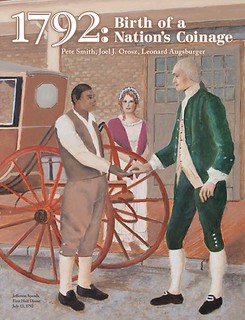 To read earlier E-Sylum articles, see:
To read earlier E-Sylum articles, see:
NEW BOOK: 1792: BIRTH OF A NATION'S COINAGE (http://www.coinbooks.org/v20/
esylum_v20n13a02.html)
BOOK REVIEW: 1792: BIRTH OF A NATION‘S COINAGE (http://www.coinbooks.org/v20/
esylum_v20n15a07.html)
SPECIAL EDITIONS OF 1792: BIRTH OF A NATION'S COINAGE (http://www.coinbooks.org/v21/
esylum_v21n05a05.html)
NEW BOOK: ENGLISH SILVER CROWNS
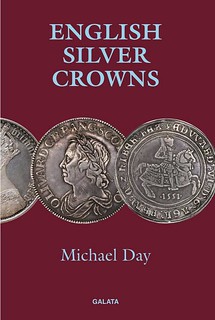 Just published by Galata Print Ltd, English Silver Crowns by Michael Day, edited by Paul and Bente Withers, with a foreword by Graham Dyer, OBE, FSA, Senior Research Curator of the Royal Mint Museum. Published by
Galata Print Ltd. Hardback. Size 156 x 234mm (6 x 9.25 inches approx.) 228 pages. Illustrated throughout in colour with photographs. Extensively and carefully indexed, and for the academic, five pages of footnotes.
Just published by Galata Print Ltd, English Silver Crowns by Michael Day, edited by Paul and Bente Withers, with a foreword by Graham Dyer, OBE, FSA, Senior Research Curator of the Royal Mint Museum. Published by
Galata Print Ltd. Hardback. Size 156 x 234mm (6 x 9.25 inches approx.) 228 pages. Illustrated throughout in colour with photographs. Extensively and carefully indexed, and for the academic, five pages of footnotes.
The English silver crown has a long history, beginning in 1551. Its many varieties have already been well catalogued, so what makes this new book different enough to warrant buying it ? This book is different because it
focusses not on the manifold varieties, but on the history of the coin, its production, its engravers, and the times in which the coin was produced, starting from the first in 1551, until the present day.
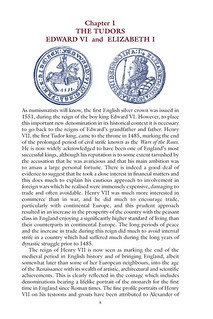
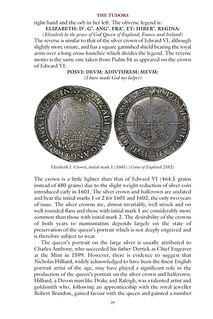
The personality and education of each monarch, the working and politics of the Royal Mint, and the political, economic and social changes in the country are all discussed. Although it is difficult to measure inflation over a period of more than 450 years, that has been attempted, based on published contemporary prices and wages.
Methods of manufacture are discussed, as well as the mechanics of calling in the debased coins by Thomas Gresham, and of replacing them with fine coins. The personalities of people such as some of the best-known names in numismatic art, including Thomas Simon, the brilliant but importunate Benedetto Pistrucci, and the even more brilliant and hard-working William Wyon.
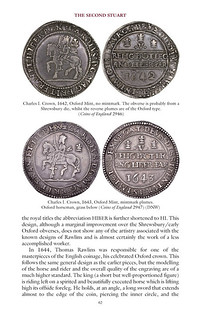
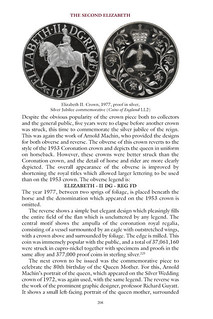
The collector of modern issues has not been ignored either, as he has been in most publications since the 1950s. All has been carefully researched, including such details as the identity of the model who sat in for the queen for the coronation crown.
Available from www.galata.co.uk, website number 11028.
Further information and sample pages on http://www.galata.co.uk/store.asp?storeAction=showDetail&stockID=11028&stockMasterCategoriesID=259

NEW BOOK: THE MEDALS OF FREDERICK WILLIAM II
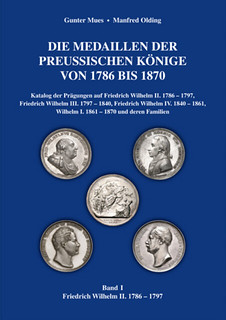 The Medals of the Prussian Kings from 1786 to 1870, Volume 1
The Medals of the Prussian Kings from 1786 to 1870, Volume 1
Manfred Olding, Gunter Mues
Friedrich Wilhelm II. 1786 - 1797
1st edition 2018
120 pages, 21 x 29.7 cm, full color illustrations, hardcover
Publication Date: available
ISBN: 978-3-86646-161-1
Price: 69,00 EUR
Fifteen years after the publication of his work on the medals of Frederick the Great, the sequel to the Prussian medal art by Manfred Olding in collaboration with Gunter Mues appears. The book contains the medals of King Frederick William II and his family, eg Queen Wilhelmine of the Netherlands, wife of William I, King of the Netherlands from 1815.
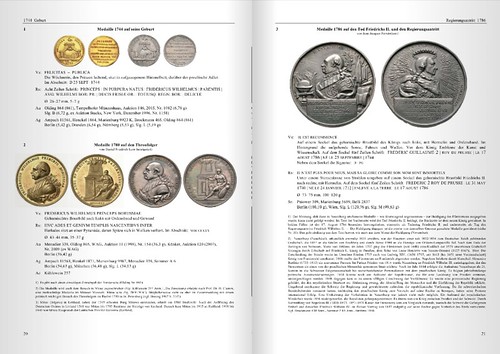
For more information, or to order, see:
Manfred Olding, Gunter Mues The Medals of the Prussian Kings from 1786 to 1870, Volume 1
(http://www.gietl-verlag.de/die-medaillen-der-preussischen-koenige-von-1786-bis-1870-band-1/buchdetail/793/6/0/2.html)
MANFRED OLDING MÜNZENHANDLUNG (http://www.manfred-olding.de/shop/lagerliste.htm)
To read the complete CoinsWeekly article, see:
The Medals of Frederick William II (http://www.coinsweekly.com/en/News/The-medals-of-Frederick-William-II/4?&id=5326)
NEW BOOK: TAIWAN TELEPHONE TOKENS
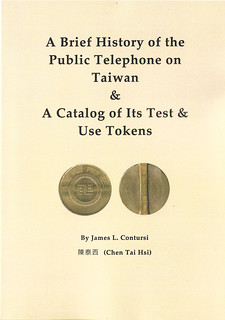
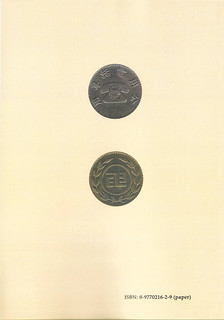
James Contursi has written and published a new book on the telephone tokens of Taiwan. He writes:
The full title is A Brief History of the Public Telephone on Taiwan & a Catalog of Its Test & Use Tokens. It’s 28 pages in length and contains, as the title indicates, a brief history of the public telephone on Taiwan; information on availability and pricing of these tokens; a priced catalog of Taiwan’s telephone use and test tokens, consisting of 18 examples (2 use, 15 test, 1 check), attributed and pictured in color, obverse and reverse; notes; and bibliographical references. The History is in English; the Catalog is in Chinese and English. Priced at $7.95 plus shipping, it should be considered bargain.

NEW BOOK: LOTS OF FAITH AND LOTS OF PENNIES
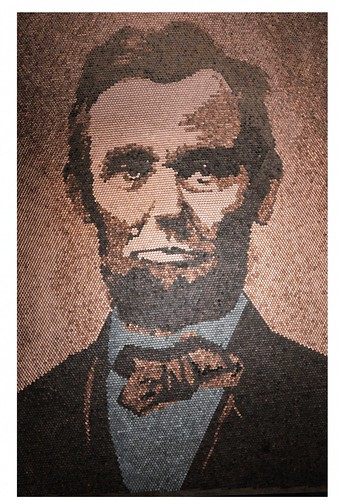 A prizewinning portrait of Abraham Lincoln will remain on display in Battle Creek until the fall of 2018.
A prizewinning portrait of Abraham Lincoln will remain on display in Battle Creek until the fall of 2018.
Battle Creek resident Richard Schlatter’s piece, the winner of the ArtPrize 9 Public Vote $200,000 grand prize, was slated to return in September to the Grand Rapids festival. However, the ArtPrize 10 committee negotiated an agreement with Schlatter to allow the piece to stay in Battle Creek.
Schlatter, a graphic designer and artist of the renowned A. Lincoln ‘penny portrait’, met with ArtPrize organizers on March 16th where he learned of the decision. "I was relieved...because each time it is moved is cause for concern that it might get damaged," noted Schlatter.
ArtPrize is the largest art festival in the world, according to their website. After taking the festival’s top honor in 2017, the 450-pound A. Lincoln was moved by a moving truck to Battle Creek. The portrait is currently displayed at the Battle Creek Community Foundation at 32 W. Michigan Ave., where it arrived last October. The piece is 12-feet high by 8-feet wide and does not fit through standard doorways. A window on the exterior of the foundation building was removed to accommodate the large size of the piece as seven art handlers carefully maneuvered it into the gallery.
Since its installation in Battle Creek, over 6000 people have visited A. Lincoln in the gallery, which features photos of the portrait’s creation, books on Lincoln, and memorabilia from the president’s assassination. The exhibit is open to the public Tuesday through Saturday from 11am to 3pm through the end of May. Summer and fall hours will be announced at a later date. School classes and other groups can schedule private showings with a docent by contacting the Battle Creek Community Foundation.
In lieu of the piece returning to Grand Rapids for ArtPrize, a book about A. Lincoln will be sold at the festival. My ArtPrize Journey: Lots of Faith and Lots of Pennies, is more than a narrative of how I did it. It is a story of perseverance, of keeping my faith strong against what seemed at times to be insurmountable odds.” The book will retail for $10. Schlatter’s book will be available for Battle Creek’s ‘Spring into the Arts’ festival May 18, 2018 and will be on sale at the Battle Creek Community Foundation gallery. Advanced copies of the book may be reserved, and speaking events featuring artist Richard Schlatter may be arranged by emailing jill@bccfoundation.org .
“The past five months have been gratifying and rewarding in many ways,” says Schlatter of his experience. “The role the Battle Creek Community Foundation has taken in creating a venue for displaying . Lincoln speaks to their commitment to the community. I feel blessed to not only share my story but to bring attention to Battle Creek as the home of the ArtPrize 9 grand prize winner. It truly has been a life-changing experience.”
To read the earlier E-Sylum articles, see:
ARTIST WINS AWARD FOR LINCOLN PENNY PORTRAIT (http://www.coinbooks.org/v20/esylum_v20n43a22.html)
RICHARD SCHLATTER’S 'A. LINCOLN' PORTRAIT (http://www.coinbooks.org/v20/esylum_v20n46a29.html)
BOOK REVIEW: CONFISCATION
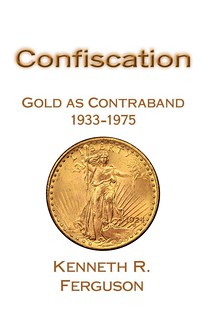 Confiscation: Gold as Contraband 1933-1974 by Kenneth R. Ferguson was a pleasure to read. Ferguson writes very well. I met Ken Ferguson in person last weekend at a coin show here in Austin. He speaks as
intelligently as he writes. Our time together was enlightening.
Confiscation: Gold as Contraband 1933-1974 by Kenneth R. Ferguson was a pleasure to read. Ferguson writes very well. I met Ken Ferguson in person last weekend at a coin show here in Austin. He speaks as
intelligently as he writes. Our time together was enlightening.
The book provides a close and yet conversational examination of Franklin D. Roosevelt’s executive orders and the related Congressional acts that became laws. Few people ever get past citing Executive Order 6102 and most often stop short of fully citing and discussing that document. This book delivers the facts.
Ferguson tells the whole story, going past 6102 to the subsequent orders and laws. He lays out carefully and logically the many relevant details that highlight this singular event. He examines the public response. He explains how and why Britain, France, and Switzerland returned to striking gold coins after World War II using dies from previous years.
As a nod to the bibliophiles here, I note that the book is set in 11-point Garamond, which the user experience designers here in Austin assure me is the new standard in Roman (serif) fonts.
To read the earlier E-Sylum articles, see:
NEW BOOK: CONFISCATION: GOLD AS CONTRABAND (http://www.coinbooks.org/v21/esylum_v21n12a04.html)
BOOK REVIEW: CONFISCATION (http://www.coinbooks.org/v21/esylum_v21n15a05.html)

SCRIPOPHILY APRIL 2018 ISSUE PUBLISHED
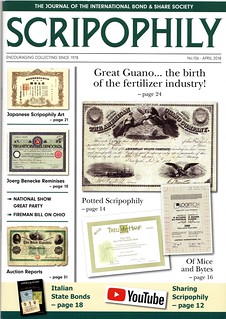 The new issue of Scripophily, the thrice yearly publication of the International Bond and Share Society, has just been mailed to the 400 worldwide Society members.
The new issue of Scripophily, the thrice yearly publication of the International Bond and Share Society, has just been mailed to the 400 worldwide Society members.
It contains an article about the 19th century guano industry and companies organized to mine bird doo - which at the time was the acme of fertilizer. Despite the unappealing nature of the companies' product, their US stock certificates include some of the most decorative examples from the period.
Other articles include marijuana stocks, companies in the history of the computer mouse, Italian State bonds, Japanese financial art and stock and bond auction reports along with news of interest to collectors of vintage
securities.
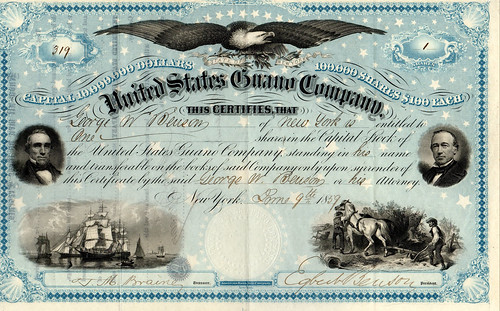
This share in the US Guano Co was printed by the American Bank Note Co. The company issued it in 1859 to finance avian guano excavation on Howland Island in the south Pacific. Howland Island is better known today for the bird that never arrived - Amelia Earhardt.
Subscriptions come with the $32 Society annual membership at https://scripophily.org/ .
DAVID BAILEY (C1946-2018)
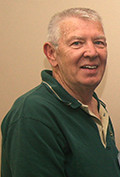 Ray Williams of New Jersey writes:
Ray Williams of New Jersey writes:
David Bailey has passed away. He was the current president of our state organization, the Garden State Numismatic Association, immediate past president of the New Jersey Numismatic Society, and past president of the Watchung Hills Coin Club. He was a victim of lung cancer, which he battled for several months. David was a numismatic collector/researcher specializing in Conder Tokens and French Jetons. He shared his hobby by being active in clubs and giving numismatic presentations across New Jersey and New York. He will be sorely missed by family, friends and our hobby.
David Gladfelter writes:
Shocked to hear this – must have been sudden, he attended the November Whitman Expo in Baltimore where I last saw him. The current issue of GSNA Journal has Dave’s comments as retiring president. Dave was an energetic and willing worker and had fun doing it. He collected people as well as coins. A GSNA spark plug. In addition to his GSNA membership, belonged to both ANA and ANS.
 It is difficult to believe that ten years ago, Spencer Peck handed me the gavel and introduced me as the new president of the GSNA. It is now time for me to step down.
It is difficult to believe that ten years ago, Spencer Peck handed me the gavel and introduced me as the new president of the GSNA. It is now time for me to step down.
I have treasured the honor of being your president, and I am proud to have served all of you for the past ten years. I was greatly assisted by my governing board, as well as the great support of our membership. I was fortunate, that whenever I lost a fabulous board member, someone eagerly jumped in to fill the breech.
Looking over my term I would like to highlight some accomplishments that the GSNA has made in order to keep it relevant with today’s collector:
1. We have had ten successful shows. (Thank you, Tom Hyland.)
2. The printed and mailed journal of the twentieth century has been replaced by a digital journal emailed to our membership, thanks to the efforts of Joe Pargola (our editor) and Eric Knapp, (our webmaster). This conversion was extremely time consuming but the results were worth it. Joe can produce a very outstanding journal, in color, without any restrictions of size or postage / printing costs limitations. The journals are now delivered to the membership, on time, and on a regular quarterly basis, while saving the GSNA thousands of dollars. This enabled us to keep the dues at a very reasonable ten dollars a year.
3. A journal editor needs great articles in order to create a great journal. Since we no longer have to spend money to print the journal, the GSNA now is able to pay $50.00 to the GSNA member who submits an original article that is published in the journal. This program has provided our editor with a backlog of quality numismatic articles to choose from. If you ever had an idea that you wish to share, consider contacting Joe, and he will guide you in creating an article to be shared with the whole NJ numismatic community.
4.Realizing that local clubs are the heart of New Jersey numismatics, we put into effect a “Member Club Technology Assistance” program whereby the GSNA would reimburse a mem ber club for half the expense of digital presentation equipment (up to $400). This equipment can elevate the presentation and “Show and Tell” experience to be enjoyed by all members.
5. “Speakers Stipend” - In order to assist member clubs in obtaining quality speakers, the GSNA instituted a guest speakers stipend of $25.00 to help offset the travel expenses of GSNA members who give a presentation at any GSNA member club - one in which they personally are not a member.
As president, I was most fortunate to have a super great board assisting me along the way - both past and present members. Thank you all.
For more information on the Garden State Numismatic Association, see:
http://www.gsna.org/

JOHN PETT (1951-2018)
John Pett passed away on Sunday 22 April, 2018. He was born in Hove, Sussex on 14 August 1951. He was the second eldest of four brothers. After attending Brighton College, he went to Nottingham University where he studied Classics. During his studies he met his wife Adele, and soon after graduating he started working at Spink and Son Ltd, in London, in 1974.
He was trained in the finer points of numismatics by George Muller, who, in turn, had been fortunate to have served his own apprenticeship, from the late 1940s, at Spink’s, under that pre-eminent dealer in ancient coins, Leonard Forrer Sr. (1869-1953). John produced most of the lists of ancient coins for sale that appeared in the Numismatic Circular between the mid-1970s, until Spink’s ceased to publish it in 2012, and provided the cataloguing for many auction sales Spink’s had that included ancient coins between 1978 and 2017. He often travelled to Coin Fairs all over the world, on behalf of the company, and occasionally he represented Spink’s at Congresses organised by the International Association of Professional Numismatists (IAPN).
John stayed at Spink’s for his whole working life, retiring in September 2017, to become a Consultant to the company, and during those 43 years, he never lost his enthusiasm for ancient coins. He built on the knowledge he had gained from working with George, and he took over the management of the Ancient Coin Department at Spinks in the late 1980s. During his time there he was instrumental in helping to form innumerable important collections, in all parts of the world, of Greek, Roman and Byzantine coins, some now dispersed, but many still on-going. The owners of many such collections have been fortunate to have profited from advice and help given by John in his typically unassuming but knowledgeable manner. He had a wonderful “eye” for a nice coin. In the words of a well-respected collector, John was a good person through and through, made of a superior substance. They don't make them like that anymore. His word was better than a written contract and his low-key opinion carried more weight than many fancier ones.
John was diagnosed with a severe form of cancer in the early 2000’s and the determined way in which he coped with the side-effects of the treatment was quite remarkable – and as a result he earned the admiration and respect of all of us at Spink’s who were aware of his situation – and many of his customers who he continued to see in his office at the old company, almost on a daily basis. Yes, they were his customers- at Spink we all had our customers - it was all a part of the service we provided then. He will be very much missed by all of us involved in the numismatic world.
In her Newsletter #66 published April 27, 2018, dealer Shanna Schmidt writes:
On Wednesday morning I remotely attended the DNW auction. There was a moment of silence and a beautiful tribute to John Pett, who died last Sunday. Those that knew Mr. Pett, formerly of Spink & Son, were fond of him.
R. TETTENHORST
Bill Eckberg of Florida writes:
You might mention that Bernard Edison was known in numismatic circles as R. Tettenhorst. He even had fake ID in that name. A great gentleman and a good friend who LOVED his half cents and his numismatic friends.
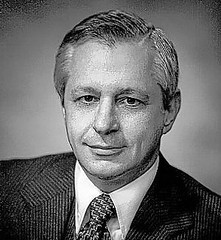 Last week we announced the passing of famed U.S. Half Cent collector Bernard Edison, obliquely referencing his pseudonym "R. Tettenhorst". He was known as "Tett" in the early American copper
collecting community.
Last week we announced the passing of famed U.S. Half Cent collector Bernard Edison, obliquely referencing his pseudonym "R. Tettenhorst". He was known as "Tett" in the early American copper
collecting community.Here's an excerpt from an April 26, 2018 CoinWeek article. See the complete article online. It includes an audio podcast (by Bill Eckberg) and video interview (by Charles Morgan) with Tett. -Editor
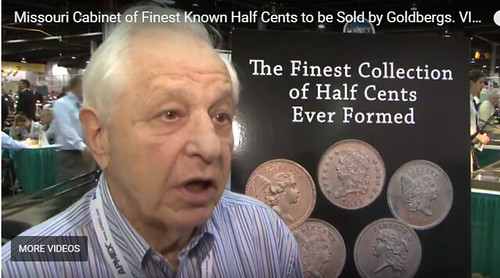
Bernard Alan Edison, the collector responsible for one of the all-time great collections of copper United States Half Cents, has passed away. He was 90 years old.
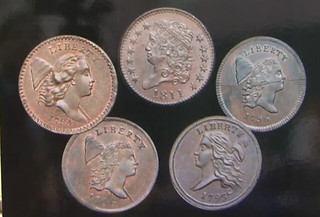 Better known in the wider hobby by the nom de coin “R. Tettenhorst” (which was actually the name of his secretary, to whom his packages were addressed), Bernard Edison–“Bunny” to his friends–carefully assembled his
collection over a lifetime of business and civic success in the St. Louis, Missouri area. A member of the Edison family of Edison Brothers Stores fame, Bernard was born on March 23, 1928.
Better known in the wider hobby by the nom de coin “R. Tettenhorst” (which was actually the name of his secretary, to whom his packages were addressed), Bernard Edison–“Bunny” to his friends–carefully assembled his
collection over a lifetime of business and civic success in the St. Louis, Missouri area. A member of the Edison family of Edison Brothers Stores fame, Bernard was born on March 23, 1928.
It might be worth noting that fellow St. Louis coin collector (and Edison’s relative through marriage) Eric P. Newman worked as an executive vice president at the company during this same time period.
To read the complete article, see:
Bernard Alan Edison, aka “R. Tettenhorst” (1928-2018): In Memoriam
(https://coinweek.com/people-in-the-news/in-memoriam/bernard-alan-edison-aka-r-tettenhorst-1928-2018-in-memoriam/)
To read the earlier E-Sylum articles, see:
BERNARD ALAN EDISON (1928-2018) (http://www.coinbooks.org/v21/esylum_v21n16a07.html)
ROSE M. TETTENHORST (1936-1989) (http://www.coinbooks.org/v21/esylum_v21n16a26.html)
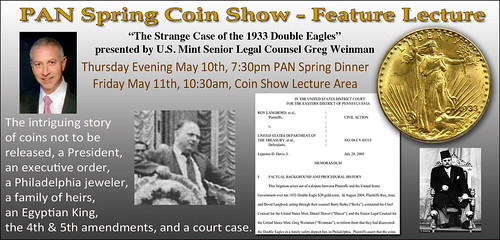
SAMPLE SLAB UPDATE NEWSLETTER ON NEWMAN PORTAL
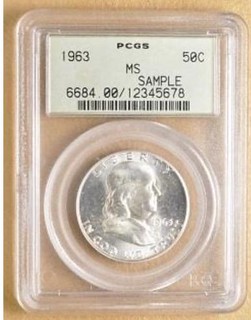 The latest addition to the Newman Portal is David Schwager’s Sample Slab Update Newsletter #25. The collecting of slab variants is surprisingly robust, and this publication documents a rare PCGS example
which recently traded at over $1,000 (illustrated here). The “plastic tomb” has revolutionized the numismatic trade in the latest generation, and Schwager echoes a sentiment with which we heartily agree:
The latest addition to the Newman Portal is David Schwager’s Sample Slab Update Newsletter #25. The collecting of slab variants is surprisingly robust, and this publication documents a rare PCGS example
which recently traded at over $1,000 (illustrated here). The “plastic tomb” has revolutionized the numismatic trade in the latest generation, and Schwager echoes a sentiment with which we heartily agree:
“This may never happen, but someone needs to write the history of coin certification soon. Many of the people who founded the first certifier, ANACS, in 1972 are already gone. By the time I retire in the 2030s and can devote myself full time to numismatics, the certification pioneers of the 1980s may no longer be with us, either. A history book would sell few copies — it’s easier to interest people in a price guide. Still, certification has changed our hobby so much in the last 30+ years that this is a story that needs to be told….”
Link to the Sample Slab Update Newsletter on Newman Portal:
https://nnp.wustl.edu/library/publisherdetail/514437
NEWMAN PORTAL SEARCH: WASHINGTON GRATE CENT
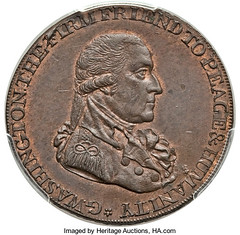
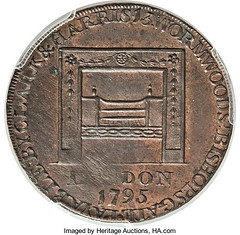
This week a Newman Portal user searched for the term “Washington Grate cent.” Having never heard of such a thing, I thought perhaps “grate” was a typo for “great.” Not the case, and we quickly learn from the 1977 ANA auction sale catalog (lot 58) that this piece is classified as “Baker 92a” in the Washingtonia series. This is where the typo is, for a check of the Baker reference indicates the correct attribution is actually Baker 29a.
Nevertheless, the auction catalog pointed us in the right direction. From here one can not help but pick from the shelf Neil Musante’s Medallic Washington to learn more. Computers are fabulous for search but sometimes one likes to use a hardcopy. Musante details two varieties, GW-49 and GW-50, which are quite similar in design, but struck from two different dies. The pieces are English, with obverse bust of Washington and the reverse legend PAYABLE BY CLARK & HARRIS 13 WORMWOOD ST. BISHOPSGATE.
Has an auction house ever cataloged this token as a “great grate cent?” A Newman Portal search suggests not, though it seems a cataloger pressed for time might be sorely tempted to do so!
Image: Washington Grate Halfpenny, from Heritage Auctions (1/2015, lot 3060), realized $998.75
Link to Kagin’s 1977 ANA auction sale catalog on Newman Portal:
https://nnp.wustl.edu/library/auctionlots?AucCoId=511063&AuctionId=518291&page=25
Link to Baker’s Medallic Portraits of Washington:
https://nnp.wustl.edu/library/book/512400

2018 HIGGINS NATIONAL BANK NOTE SEMINAR
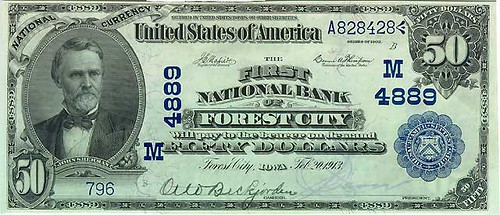
The Higgins Museum 2018 National Bank Note Seminar is scheduled for Thursday, July 26, at the museum in Okoboji, Iowa. Six prominent speakers have been scheduled; Peter Huntoon, Mark Drengson, Steven J. Sweeney, Larry Adams, Michael B. Scacci, and Mark B. Anderson. Continental breakfast treats will be available at eight o’clock on Thursday morning, with the program scheduled to get underway at 8:45.
Headlining the speaker sessions will be National Bank Note authority Peter Huntoon, with a scholarly presentation on the 1873 to 1885 currency design era that was dominated by the work of George Casilear. As chief engraver at the Bureau of Engraving and Printing, the patented lettering process developed by designer and inventor Casilear dominated every new series of currency produced over that time-frame.
Minnesota specialist Mark Drengson will provide attendees with an insightful examination – National Banks, Bankers and Banknotes of Southern Minnesota – concentrated on his focus on the issues of the southwestern corner of the state. Past Society of Paper Money Collectors president Mark Anderson will offer an exploration – A Tale of Two Wisconsin Banks; Comparable Inceptions, Divergent Outcomes – of a pair of the state’s rural banks that shared close proximities, drawing upon banking history recorded by his grandfather.
Steve Sweeney, co-author of the Iowa National Bank Notes reference and the project’s still active “census keeper” will contribute – The Iowa Census; Evolving & Maturing – providing valuable insights into the value and vagaries of census records. Higgins curator Larry Adams and president Michael Scacci will jointly explore counterfeits – Reasons to Not Fire an Engraver; Counterfeits from 1862 to 1920 – a presentation tied to the Bob McCabe reference Counterfeiting and Technology.
The registration fee for the seminar is $75. Registration applications and remittances should be directed to The Higgins Museum, 1507 Sanborn Avenue, P. O. Box 258, Okoboji, IA 51355. The Society of Paper Money Collectors is the lead co-sponsor of the seminar. Other sponsors are the Central States Numismatic Society and the Professional Currency Dealers Association. (A discounted registration fee of $60 is available to members of he SPMC, CSNS, PCDA and the Iowa Numismatic Association.
There are several overnight accommodation possibilities that are a mile or less away from The Higgins Museum. The include AmericInn Lodge, 105 Brooks Park Drive (just off U.S. Hwy 71) 1- 800-634- 3444 (reservations) or 1-712- 332-9000 (direct); Arrowood Resort, 1405 U.S. Hwy. 71, 1-800- 727-4561 (reservations) or 1-712- 332-2161 (direct); Vintage Block Motel, 1107 Sanborn Avenue (just two blocks from the museum) 1-712- 332-8040 (reservations and direct); Bridges Bay Resort, 640 Linden Drive, 1-800- 727-4561 (reservations) or 1-712- 332-2022 (direct). Early arrivals from outside the area are invited to attend a welcome reception from 5:00 pm to 6:30 pm on Wednesday evening, July 25.
Established in 1978 by William R. Higgins, Jr., The Higgins Museum of National Banking is dedicated to the acquisition, preservation, display and educational sharing of artifacts and reference materials related to the 1861-1935 National Bank Era. Open Tuesdays to Sundays from Memorial Day weekend to Labor Day weekend, the museum displays the country’s largest collection of National Bank issues on permanent exhibit, with emphasis on Iowa and the nearby areas of its adjoining states. It incorporates numerous period furnishings and equipment associated with the key role that National Banks played in the economic development of the United States. Admission to The Higgins Museum is free.
For additional information on the 2018 Higgins Museum National Bank Note Seminar, please contact curator Larry Adams at 515-432- 1931, or direct your inquiry by e-mail to: ladams@thehigginsmuseum.org
For more information on the Higgins Museum, see:
http://www.thehigginsmuseum.org/
2018 BOSTON MCA CONFERENCE UPDATE
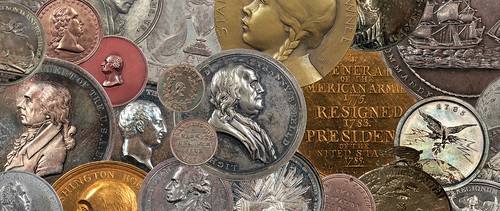
Art and Memory: The Role of Medals
Conference organized by the Medal Collectors of America and the Massachusetts Historical Society Saturday, November 10, 2018, 8:00AM - 6:30PM, at the MHS, 1154 Boylston Street, Boston, MA Dinner afterward (at Brasserie JO), 7:00PM – 9:00PMThe Medal Collectors of America and the Massachusetts Historical Society have teamed up to organize an unprecedented conference on medals and medal collecting this fall in Boston. The theme, Art and Memory: The Role of Medals, was chosen to have wide appeal, with social events added to provide some fun, and encourage discussion among medal collectors and others who are not yet collectors, all in an extraordinary location.
This conference will include a series of presentations on the role medals have played in American history, the evolution of medallic art, and the ways medals have reflected American culture up to the 21st century. Presenters will include:
• Len Augsburger, Coordinator, Newman Numismatic Portal, Washington University in St. Louis, will speak on the history of medal books
• Anne Bentley, Curator of Art & Artifacts, Massachusetts Historical Society, will speak on the Society’s extensive medal collection and its fascinating history
• Jonathan Brecher, co-author of “So-Called Dollars: An Illustrated Standard Catalogue”, will speak on So-Called Dollars as a reflection of nineteenth and early-twentieth century American culture
• Patrick McMahon, Director of Exhibitions, Museum of Fine Arts, Boston, will speak on the early work of Victor David Brenner, sculptor of the Lincoln Cent and many medals
• Alan Stahl, Curator of Numismatics, Princeton University, and previously curator for many years at the American Numismatic Society, will speak on the role of medals in American history
In addition, two panel discussions will focus on the artistic beauty and collectability of medals. One panel discussion will cover the stylistic developments from Renaissance medallic art to contemporary art medals (“The Art of the Medal”). The second panel will explore the individual passions that drive numismatists to build their unique collections (“Why Collect Medals?”). Panelists will include several noted numismatists: John W. Adams, Q. David Bowers, Cory Gilliland, Scott Miller, Ira Rezak, Rob Rodriguez, John Sallay, and Stephen Scher.
Anne Bentley will also arrange a special exhibit of medals from the fabulous MHS collection, including the unique Comitia Americana set of silver medals presented by Thomas Jefferson on behalf of Congress to George Washington in 1790, the unique gold Manly medal, a silver Columbia and Washington medal, and many more rare and extraordinary pieces.
Founded in 1791, the Massachusetts Historical Society is the nation’s first historical society and an invaluable resource for American history, life, and culture. In addition to its incomparable numismatic holdings, the MHS collections are particularly well-known for extensive holdings of personal papers from three presidents: John Adams, John Quincy Adams, and Thomas Jefferson. The collections contain many famous documents including Paul Revere's own account of his famous ride and Abigail Adams’s famous "Remember the Ladies” letter to John Adams, where she advocates for the rights of women to be included in the founding of the United States, among many other treasures.
The Medal Collectors of America is a national organization dedicated to the study and collection of artistic and historical medals. The MCA was founded in August 1998 at the Portland, Oregon convention of the American Numismatic Association to bring together those interested in collecting, research, and the publishing on all types of medals. Its quarterly publication, The MCA Advisory and the MCA website provide a forum for research, news, and views in the field of medallic art. For further information on the MCA and MHS, please see www.medalcollectors.org and www.masshist.org.
Registration for this conference is now open at www.masshist.org/medals. Early registration is highly recommend as space is limited and pre-registration will be required. A cocktail reception at the MHS will conclude the conference in the late afternoon, followed by an optional dinner at Brasserie JO, a celebrated French bistro just a 10-minute walk from the MHS. There is a $75 per person conference fee, including lunch and the cocktail reception, with dinner afterward optional at an additional $95 per person.
John Sallay adds:
The capacity of the space at the MHS is limited to 100, and the restaurant for the dinner on Saturday night is limited to 80, so folks who plan to attend should register sooner rather than later, especially as the conference will be promoted to the MHS membership as well.
As you can see from the list of presenters and panelists, this event should be terrific and well worth the trip to Boston.
To read the earlier E-Sylum article, see:
2018 BOSTON MCA CONFERENCE PLANNED (http://www.coinbooks.org/v21/esylum_v21n01a19.html)
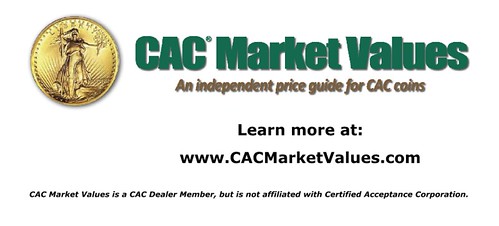
NOTES FROM E-SYLUM READERS: APRIL 29, 2018
Hans Walter Obituary
Regarding Hans Walter, web site visitor Mary Burk writes:
I live in Mansfield, Ohio and I wanted to inform you that Mr. Walter has passed away. His obit mentions Operation Bernhard, so I researched it. I read your article mentioning yourself and a friend coming to meet him.
I didn't know him or anything about the above subject, but I liked your article so much I thought I'd let you know. I think it's important to share stories such as these. I pray to God that we never, ever experience anything like the Holocaust again. May Mr. Walter finally rest in peace.
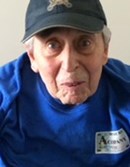 Hans Walter lived to see more in his first three decades than could fill shelves in a library. A life that was the material for a gripping memoir or historical movie ended quietly as he died peacefully in his sleep
on Friday, April 20, 2018 in Whetstone Gardens and Care Center. He was 96.
Hans Walter lived to see more in his first three decades than could fill shelves in a library. A life that was the material for a gripping memoir or historical movie ended quietly as he died peacefully in his sleep
on Friday, April 20, 2018 in Whetstone Gardens and Care Center. He was 96.
Born December 14, 1921 in Berlin, Germany, to O. August and Pauline (Flatow) Walter, Hans came to this country in 1951, a survivor of five concentration camps - including Auschwitz. Hans was the last surviving member of the Jewish prisoners used in the Nazi counterfeiting exercise Operation Bernhard.
He was a life member of both the NRA and Kol Israel Foundation, a former member of Emanuel Jacob Congregation and retired from General Motors in 1980 as a model maker with 25 years of service.
To read the complete article, see:
Hans Walter 1921 - 2018
(https://www.legacy.com/obituaries/mansfieldnewsjournal/obituary.aspx?n=hans-walter&pid=188818010&fhid=22472)
To read the earlier E-Sylum articles, see:
OPERATION BERNHARD SURVIVOR HANS WALTER (http://www.coinbooks.org/esylum_v18n31a33.html)
OPERATION BERNHARD WORKER HANS WALTER (http://www.coinbooks.org/v21/esylum_v21n16a09.html)
More on Ray Lockwood
Pete Smith writes:
The April 1 issue of The E-Sylum reported on the death of Ray Lockwood on March 29, 2018. He was a friend I knew through the Central States Numismatic Society. He collected conventional things like encased coins. I also remember him for his collection of clocks with coins on the clock face.
The May issue of The Numismatist has a memorial for Walter R. Lockwood, Jr. of Marion, Indiana. His funeral notice confirms that this is the man we all knew as "Ray."
I did a search of back issues of The Numismatist. He was most frequently mentioned as Ray Lockwood and less frequently as W. Ray Lockwood. I could not find a single reference in The Numismatist to him as Walter R. Lockwood, Jr., until his death.
To read the earlier E-Sylum article, see:
RAY LOCKWOOD (1939-2018) (http://www.coinbooks.org/v21/esylum_v21n13a10.html)
Byzantine Gold Coin Bracelet Stolen
Jim Bulmer of Hornby Island, British Columbia writes:
Last Tuesday my wife Barbara and I traveled from Mannheim to Essen on the ICE train, and when we arrived, found that my wife's purse had been removed from her backpack somewhere en route. In it were all the usual things which will be a pain in the neck to replace, but there was also a gold bracelet we had just purchased. Thankfully our passports and my credit cards were not in it, but the bracelet is unique.
It consists of six Byzantine solidi from Justinian to Heraclitus and one holed late Constantinian. The clasp is an ancient black intaglio seal of Zeus and his Eagle.
The coins are typical Byzantine Solidi, one with 3 standing figures, one with obverse about 30% off center, and a couple of Facing Armoured bust type. The seal is black, about 1 1/4" encased in gold, Crowned Zeus in top half, Eagle in bottom half.
My friend who gifted it to us told us these jewelry pieces are now very rare as most have been broken and melted. This one is about 100 years old and made of genuine pieces.
The police were notified immediately and detailed descriptions taken...Nothing to do but wait. If the robbers were smart, they would have melted it immediately, but if they weren't, and one decided to sell it, maybe it will appear in the trade.
This was the work of professionals...they were fast, quiet and efficient, and probably worked as a team. This was our first theft in 25 years of train travel, and we were careful...but not enough. Thankfully we visited with friends who let us vent and helped us calm down.
As a side note, we were near Koblenz for the EUCOPRIMO ( European Collectors of Primitive Money) conference....Which was Fantastic!
The Enigma of the Famed 1862 Rupee
Pabitra Saha writes:
You recently published an article from Bangladesh numismatist about variation in Queen Victoria coins. Similar, if not the same, is also reported by a Mumbai numismatists.
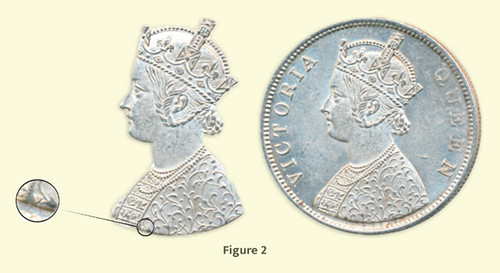
For more information on the Mumbai Coin Society, see:
http://www.mumbaicoinsociety.org/
To read the earlier E-Sylum article, see:
NEW VICTORIA BRITISH INDIAN COINAGE DIE VARIETIES (http://www.coinbooks.org/v21/esylum_v21n15a30.html)
Fake Bactrian Coins

For more information, see:
A FLOOD OF FAKE BACTRIAN COINS (https://www.academia.edu/2077047/A_Flood_of_Fake_Bactrian_Coins)
A Flood of Bactrian Fakes (http://www.kushan.org/bibliography/bactrianhoard.php)
Medals Remembering Foreign Fighters
The memory of the foreign involvement in the Taiping war lasted long after the fall of the Taiping capital at Nanjing in 1864. The events were commemorated by various actors, Chinese and foreign, from the end of the war until the end of the treaty-port century in 1943 when the right to extraterritoriality was abrogated. This article explores the commemorations of the foreign role through three media: the issuing of medals to foreign fighters, the building of memorials to the foreign dead, and the writing of histories of the events. Across these media, different interest groups used the foreign interventions as a proxy for continuing debates about the role of foreigners in China and about China's place in the world. More broadly, the commemorations of the role of foreign fighters in the Taiping war is a case study in the transnational politics of memory.
To read the complete article absract, see:
Some Corner
of a Chinese Field: The politics of remembering foreign veterans of the Taiping civil war
(https://www.cambridge.org/core/journals/modern-asian-studies/article/some-corner-of-a-chinese-field-the-politics-of-remembering-foreign-veterans-of-the-taiping-civil-war/52F6ABFE326FD8B8378A514482A6A799)
About That Blender Test...
 Steve Bishop writes:
Steve Bishop writes:
The blender test for verifying the authenticity of the dollar bill is interesting, but since it destroys the bill in the process, not very practical.
To read the earlier E-Sylum article, see:
THE MAGNET AND BLENDER COUNTERFEIT TESTS (http://www.coinbooks.org/v21/esylum_v21n16a46.html)
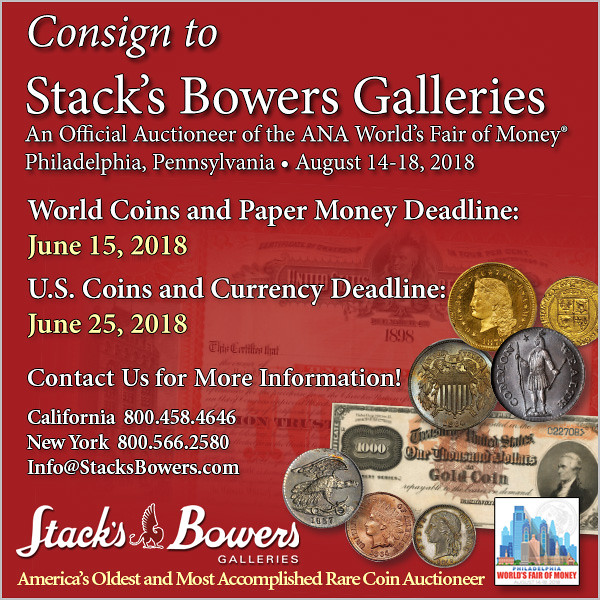
THE 2018 BROOKGREEN MEDAL
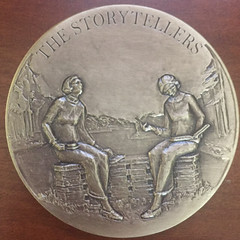
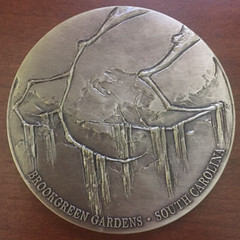
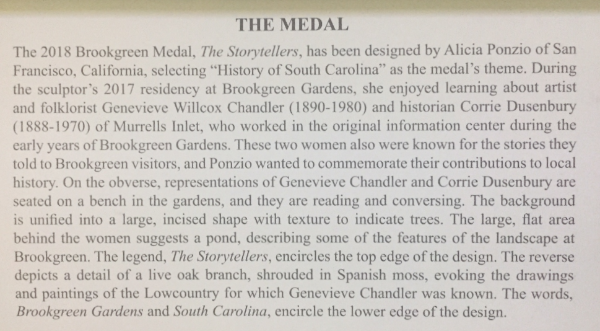

For more information about Brookgreen Gardens, see:
https://www.brookgreen.org/
VOCABULARY TERM: ADJUSTMENT MARKS
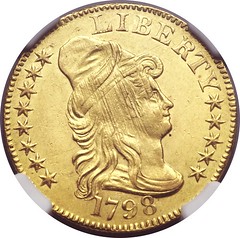

Last week we described the term Adjusting. This week is the term used to describe the results of such adjusting on a struck coin with such treatment. Note the file marks are parallel on the device; magnification would exhibit the folding over of the adjacent surface into the trough of the scratch. Photo Heritage Auctions.
Adjustment Marks. Evidence of ADJUSTING – usually file marks – seen on a struck piece. These may appear as many parallel scratches, rather than a single scratch, they may appear in the field
where it is easier to view them, or on the device, however, most filing was done near the edges. Under magnification these marks would have the appearance as light troughs but the surrounding surface most often appears to
“fold over” the edge into the crevice; this is a natural action of surface metal displacement during coining and is a diagnostic of a true adjustment mark.
CLASS 06.2
Reference:
NE42 {1982} DOTY, p 5.
Looking for the meaning of a numismatic word, or the description of a term? Try the Newman Numismatic Portal's Numismatic Dictionary at: https://nnp.wustl.edu/library/dictionary
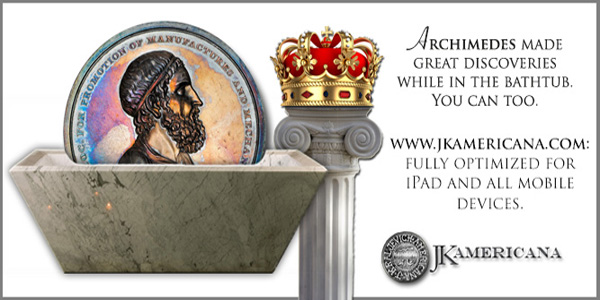
JACOB "JACQUES" SCHULMAN (1849-1914)
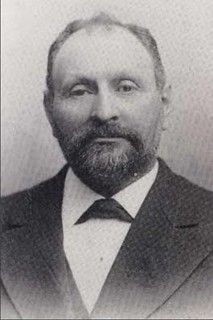 Jacob "Jacques" Schulman (1849-1914), was born at Hilversum, Province of North Holland, The Netherlands, of an affluent Jewish family, the son of David Israël Schulman (1823-), an antiquarian, jeweler,
and master clockmaker, and Grietje Spier (1821-).
Jacob "Jacques" Schulman (1849-1914), was born at Hilversum, Province of North Holland, The Netherlands, of an affluent Jewish family, the son of David Israël Schulman (1823-), an antiquarian, jeweler,
and master clockmaker, and Grietje Spier (1821-).
Jacob "Jacques" Schulman followed in his father's footsteps learning the family business. However, he and his sons as well as their heirs are internationally renown coin dealers.
In the 1860's, Jacques collected and studied coins and medals as a youth.
By the 1870's he aspired to become a professional numismatist. Soon he became an expert in Oriental, Portuguese, Brazilian and South American numismatics.
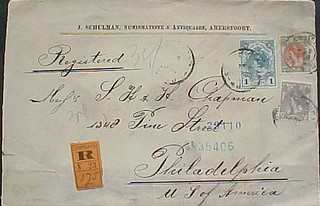 In November 1880, Jacques established the family business on the corner of the shopping district on Langestraat, Amersfoort, Province of Utrecht, 27 kilometers southeast of Hilversum. His first publication was his
fixed price list published in French, subsequently publishing fixed price lists of coins, and auction catalogs for over 60 years.
In November 1880, Jacques established the family business on the corner of the shopping district on Langestraat, Amersfoort, Province of Utrecht, 27 kilometers southeast of Hilversum. His first publication was his
fixed price list published in French, subsequently publishing fixed price lists of coins, and auction catalogs for over 60 years.
Jacques Schulman created what he called a novelty in his 1880 publication putting the text into French allowing a broader market for clientele. The Netherlands is the one of the first European countries to establish coin dealing since the sixteenth century with dealers like Abraham van Goorle of Delft (1549-1608), and at Leiden the earliest known coin auction catalogue published in 1599. With three centuries of coin dealing in the Netherlands trading in Dutch and Latin, we find Jacques Schulman publishing in French, the diplomatic language.
He is ANA member No. 653, and later given No. 1749. He was also a member of the British Numismatic Society, Koninklijk Nederlands Genootschap voor Munt- en Penningkunde, La Société Royale de Numismatique de Belgique and also the Société Suisse de Numismatique.
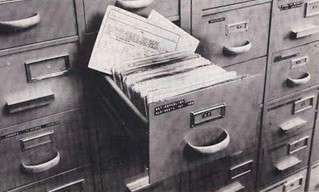 From the start Jacques Schulman kept meticulous records of every coin and medal in his inventory, sales, and auctions. These were index cards that formed a database in the exact same way libraries kept their
catalogue card index for books, and other printed materials. The 400,000 cards were donated to the ANS library in 1987.
From the start Jacques Schulman kept meticulous records of every coin and medal in his inventory, sales, and auctions. These were index cards that formed a database in the exact same way libraries kept their
catalogue card index for books, and other printed materials. The 400,000 cards were donated to the ANS library in 1987.
Jacques Schulman's catalogues are important in numismatic history and in the history of numismatic literature containing a wealth of information.
After his death in 1914, Jacques' sons Max and Andreas and grandson Jacques II continued the family business at Keizersgracht 448, Amsterdam, The Netherlands, remaining one of the most important coin houses of Europe.
To read the complete article, see:
SCHULMAN, JACQUES (https://sites.google.com/a/numismaticmall.com/www/numismaticmall-com/schulman-jacques)
The entire inventory of the Lupia Numismatic Library is for sale. Individual items will be available before the remaining archives are broken up into parcels sold at philatelic auctions in the U. S. and Hong Kong. Check NumismaticMall.com frequently as dozens of new items with estimates will be posted daily until everything is sold.
All inquiries will be given prompt and courteous attention. Write to: john@numismaticmall.com .
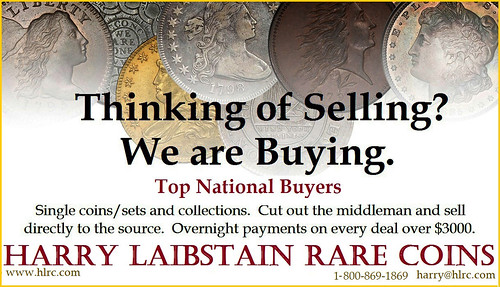
BOWERS ON THE GREAT COLLECTIONS CATALOGS
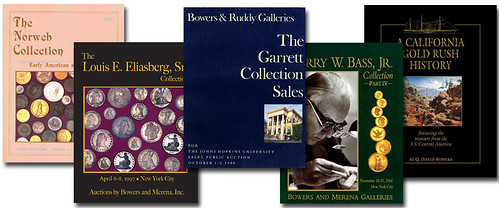
I recently heard from Christopher McDowell, a relatively new on the scene Renaissance Man researcher, now editor of The Colonial Newsletter and a major contributor to the Colonial Coin Collectors Club (not to overlook great help with some of the research I have been doing for Whitman and Stacks Bowers Galleries) In this instance, he wrote to ask who authored certain parts of a long-ago series of sales. These were the suite of four catalogs for the Garrett Collection sold by Bowers and Merena Galleries from 1979 through 1981, consigned to us by the Johns Hopkins University. My reply to Chris included much of the following.
I wrote nearly all of the Garrett descriptions with the help of George Fuld on the MEDALS. There was some staff help on other series. This involved a heck of a lot of research -- going through over 4,000 documents at the Johns Hopkins University, consulting with specialists – and also resulted in a book that became a best seller. It was a “grand adventure” that I recall with pleasure today. David and Susan Tripp at JHU, still great friends today, facilitated things.
The sale turned the market upside down. For the first time TONED coins became widely popular. Some of the prices were so off-the-wall that Abe Kosoff wrote that in calculating values, the Garrett Collection should not be considered as it was a special situation!
Later, David Tripp was instrumental in helping me and the Morgan Guaranty Trust Company with the Virgil M. Brand Collection, another “grand adventure,” that resulted in a book as well and the transforming of Virgil in popular numismatic opinion from a wealthy coin buyer who simply bought and stored coins (as Col. E.H.R. Green did) to a wealthy coin buyer who was also one of the most knowledgeable numismatic scholars of the early 20th century.
Other “grand adventures” include the Ambassador and Mrs. R. Henry Norweb, Louis E. Eliasberg, Walter Childs, Harry W. Bass, Jr. and D. Brent Pogue collections—for most of which I had a lot of staff help, with John Kraljevich doing the lion’s share of the Pogue descriptions. I wrote two books about the Pogue Collection.
Chris Karstedt in particular has been dynamic in the past quarter century with coordinating and arrangements, and numismatists on staff have been the Who’s Who in American Numismatics. Some have gone elsewhere in their careers, but John Pack’s banner still waves high at our California office. The Stack’s Bowers Galleries team includes many world=class numismatists who were not part of the aforementioned great collections, but who are front row center in sales in recent years.
Then, of course, there was and is the SS Central America, coordinated by Dwight Manley. In 2000 and 2001. I created the 1,064-page book on the treasure under an unlimited budget that facilitated research from the Library of Congress in the East to the Bancroft Library in the West. I received help from many people (Bob Evans was the star); 4,600 copies were sold, and today on the after-market they still sell for more than they did originally!
None of the above could have been done without wonderful staff help, an enthusiastic reception in the marketplace by dealers and collectors, and excellent coverage in the media.
To read the complete article, see:
Remembering Great Collections (http://www.stacksbowers.com/News/Pages/Blogs.aspx?ArticleID=2944)
THE BOOKS OF Q. DAVID BOWERS
Joel Orosz writes:
I recently had the opportunity to do some original research at the Newberry Library, Chicago's answer to Ann Arbor's Clements Library, LA's Huntington, and New York's Morgan--the repositories that have grown from the seed of the great library of a nineteenth century collector of Americana.
On a whim, I looked up my name, and found that none of my books, whether on numismatics or on philanthropy, are in the Newberry's collection. Then I tried Q. David Bowers. This produced six hits:
1. History of Wolfeboro, New Hampshire (1996)
2. Postcards of Alphonse Mucha in the Art Nouveau Style (1980)
3. Postcards of Alphonse Mucha of the Art Nouveau Period (2016)
4. Put Another Nickel In: A History of Coin-Operated Pianos and Orchestrions (1996)
5. Robert Robinson's American Illustrations (1981)
6. Wolfeboro, New Hampshire, Nothing Finer: To Commemorate Wolfeboro's 250th Anniversary, 1759-2009 (2010).
From this list, if we had nothing else to go on, we might reach the following conclusions:
1. This author is productive, but not prolific.
2. This author is mainly interested in writing about local history and art nouveau illustrators.
3. This author has only a peripheral interest in numismatics, but only through the subject of automated musical instruments.
4. This author had long fallow periods from 1982 to 1995 and again from 1997 to 2009.
I think that this is also a pretty good example of how incomplete data can lead us to misleading conclusions!
Len Augsburger writes:
Quite true. We often read too much into random evidence, only because it is the only information that has managed to survive.
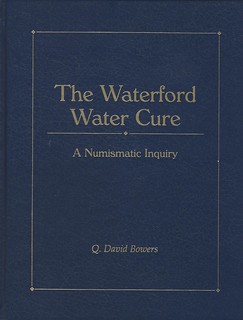
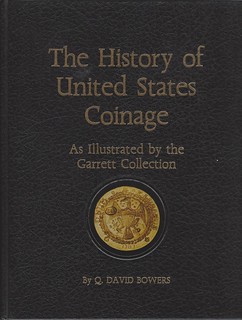
Dave Bowers writes:
John J. Ford, Jr. said his favorite of all my books was The Waterford Water Cure.
I wrote a book about Ford and have the manuscript, but then I and many others were shocked when the great counterfeiting scandal broke with Karl Moulton’s book (rumors were numerous earlier, but his friends hoped they were not true). I have the manuscript which, if ever published, needs a new ending (the same could be said today for so many figures in politics and entertainment!).
When I did The History of United States Coinage as Illustrated by the Garrett Collection, for the Johns Hopkins University, I met with JHU Press. They liked the book, but had to “think about it” as, probably, it would take 10 years to sell 1,000 copies. So, we decided to publish it ourselves. In the summer of 1979 we ordered 4,000 copies and put out a pre-publication offer. All were sold before the books were printed, We than ordered again, and I think about 15,000 copies were sold. Someone said “reading the book is like taking a university course in numismatics,” a comment I liked and have seen used since then.
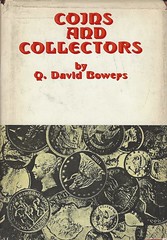 My first book, Coins and Collectors, 1964, was picked up by Crown Publishers who printed 100,000 copies and sold them at discount prices in airports, train stations, and bus stations.
My first book, Coins and Collectors, 1964, was picked up by Crown Publishers who printed 100,000 copies and sold them at discount prices in airports, train stations, and bus stations.
The Encyclopedia of Automatic Musical Instruments, 1972, which is still in print at, I think $99, by the company that took over the Vestal Press, has sold over 20,000 copies and is used worldwide. When it first came out the American Library Association recommended it on a list of “16 books every library should buy this year.” Right away, 4,000 copies were sold. Akio Morita, former chairman of Sony, asked permission to translate it into Japanese for his personal use, which I said was fine. He had two people spend two years doing that.
For Harvard University, 1996, I about 90% completed a definitive study of pallasites (a type of meteorite) under the aegis of Dr. Carl Francis of the Mineralogical Department. One way or another it lapsed, but I still have the manuscript. Partly at my suggestion, after seeing a stuffed bird that George Washington presented to someone, Harvard without my involvement printed The Rarest of the Rare, featuring items from their collection, including a meteorite from the gallery that our family presented to Harvard.
My 1,064-page book on the S.S. Central America, 2001, sold about 4,600 copies. Today on abebooks.com used copies sell for more than they did originally!.
My favorite thing to do is explore something interesting that has not been covered extensively or not at all with a reference book. I give a nod to my many wonderful research helpers over the years and to the several people who have been co-authors.
Dave's books are a delight, particularly when they take on an obscure topic in depth. Thanks for the background on the publishers and print runs. I once met Akio Morita when he spoke at Carnegie-Mellon University in the mid-1980s. I had no idea we had a mutual acquaintance, but I'm not surprised to learn it was Dave. -Editor
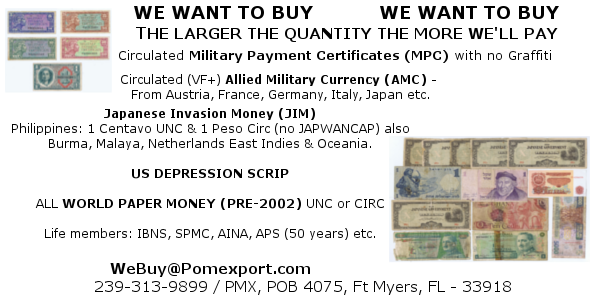
U.S. MINT SEEKS LEAD MEDALLIC ARTIST
 The United States Mint is now seeking a Lead Medallic Artist at its Philadelphia location. This position is primarily open to current or former federal employees (competitive service), surplus or displaced federal
employees, veterans, and individuals with disabilities — however, any member of the public may apply under announcement 18-MINT-175-P. The Lead Medallic Artist is a permanent, full-time position which may include travel one
to five nights per month.
The United States Mint is now seeking a Lead Medallic Artist at its Philadelphia location. This position is primarily open to current or former federal employees (competitive service), surplus or displaced federal
employees, veterans, and individuals with disabilities — however, any member of the public may apply under announcement 18-MINT-175-P. The Lead Medallic Artist is a permanent, full-time position which may include travel one
to five nights per month.
• Provide the artistic direction required during the development of coin and medal designs and models and to create designs and models for use in manufacturing hubs and or dies for United States Mint coinage, Congressional gold medals, and other devices.
• Recommend appropriate technical modifications and changes to optimize and promote efficient and effective coin and medal production.
To read the complete article, see:
Lead Medallic Artist position opens up at the United States Mint in
Philadelphia, applications accepted starting today (http://news.coinupdate.com/lead-medallic-artist-position-opens-up-at-the-united-states-mint-in-philadelphia-applications-accepted-starting-today/)
CHINESE BANKNOTE ENGRAVER MA RONG
Generally speaking, the designers and engravers of Chinese banknotes and postage stamps do not receive a lot of attention. Until recently, banknote printing was shrouded in secrecy. In 2015, the new edition of the 100-yuan note was issued, and hit the news for two specific reasons: it was China's first digitally engraved banknote and it was engraved by a woman. MA Rong is hardly a household name, but her work is known to millions.
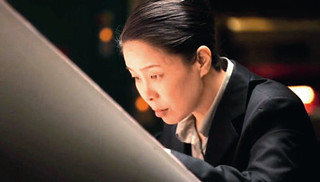 In 1978, aged sixteen, Ma Rong passed the exams to study Fine Art at the Technical School of the Beijing Banknote Printing Plant (then known as Beijing 541). The class (including her future husband, engraver Kong
Weiyuan) attended an extra course in banknote engraving, an activity that was shrouded in secrecy at the time.
In 1978, aged sixteen, Ma Rong passed the exams to study Fine Art at the Technical School of the Beijing Banknote Printing Plant (then known as Beijing 541). The class (including her future husband, engraver Kong
Weiyuan) attended an extra course in banknote engraving, an activity that was shrouded in secrecy at the time.
Ma Rong studied under ZHAO Yayun ???, known as the first female engraver in modern China. In the 1980s, she specialized in engraving portraits. Then, in 1997, she entered a competition to engrave the first solo portraits of Mao on renminbi banknotes.
She won the competition, and it is her portraits of Mao that appear on the notes in circulation today. These highly symbolic notes are the fifth series of renminbi (people’s currency), and were first issued by the People’s Bank of China in 1999, commemorating the 50th anniversary of the People’s Republic of China.
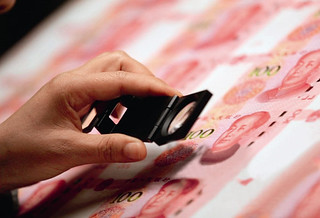 Prior to 1999, Mao’s portrait had only appeared on one banknote issued by the People’s Bank of China: the 100-yuan note featuring Mao, Zhu De, Liu Shaoqi and Zhou Enlai, dated 1980, and first issued in 1988. His
portrait did not feature on earlier notes of the People’s Bank (Tian’anmen features without Mao’s portrait), although it did appear on notes of other banks before 1949. For more info, see my paper “Mao on Money”, prepared
for “The East is Red: Art, Politics and Culture in the People’s Republic of China” study day at the V&A in 1999, and published in 2003.
Prior to 1999, Mao’s portrait had only appeared on one banknote issued by the People’s Bank of China: the 100-yuan note featuring Mao, Zhu De, Liu Shaoqi and Zhou Enlai, dated 1980, and first issued in 1988. His
portrait did not feature on earlier notes of the People’s Bank (Tian’anmen features without Mao’s portrait), although it did appear on notes of other banks before 1949. For more info, see my paper “Mao on Money”, prepared
for “The East is Red: Art, Politics and Culture in the People’s Republic of China” study day at the V&A in 1999, and published in 2003.
Ma Rong works in the Design and Engraving Studio of the China Banknote Printing and Minting Corporation. Noted as one of the fourth generation of banknote designers, she is now training the fifth generation.
To read the complete article, see:
43. MA RONG – ENGRAVER OF MAO AND MONKEYS
(https://chinesemoneymatters.wordpress.com/2018/04/26/43-ma-rong-engraver-of-mao-and-monkeys/)

THE MEDIA'S RARE COIN OVERHYPE
Almost every month there’s a new article in the press telling you to check your change in case you have a rare 20p coin worth hundreds of pounds.
Sometimes we’re told to look at notes for specific print runs or to watch out for certain designs on coins that collectors are desperate to acquire.
It’s all good fun; in fact, I’ve written plenty of those articles myself. In a way it’s like a lottery that no one pays to enter but everyone gets to play.
And I’ve certainly spent time rooting through my change looking for a date-less 20p or trying to find the Beatrix Potter 50p that everyone wants.
But because it’s such fun and frankly a rare good news money story, I’d say we money journalists often significantly overhype it.
Here’s how.
Pretty much every newspaper and website wants these coin stories to be as exciting as possible.
‘Coins worth £300!’ is a much better story than ‘You might have a coin that could sell for a little more than face value as long as you list it on eBay within the next few days before the collectors all finally get one’.
Crucially, instead of reading about what these coins are actually worth, we’re instead told ‘such and such coin is already going for £300 online’.
It’s so misleading. Something’s value is not represented by what the owner wants to sell it for; it’s about what it actually sells for.
When a coin is known to be relatively rare or in demand there will always be chancers who list them for several hundred-times their value. And who honestly can blame them for trying their luck?
But this is immediately seized upon by financial journalists and bloggers as further proof of the coin’s value, leading to news stories claiming the coins are ‘going for’ fantastic amounts.
In actual fact, they are being listed for that amount not sold, but that’s rarely made clear to the reader. This is something we at loveMONEY try to make clear in all our articles on rare notes and coins. Ultimately, if something is worth far more than face value, chances are it's going to be really rare.
To read the complete article, see:
Opinion: rare and valuable coins are expensive for a reason
(https://www.lovemoney.com/news/73352/rare-coins-value-ebay-misleading-fake-sale)
HOLABIRD AMERICANA MAY 2018 AUCTION SELECTIONS
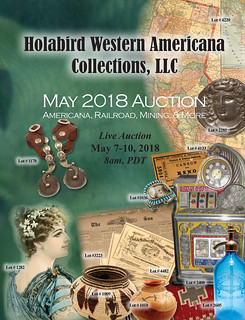 The Holabird May Sale has a wide variety of numismatic material. It starts with approximately 250 lots of tokens, highlighted by an Elko, Nevada Good-For mirror and nearly 200 lots of the historic RB Worthington
Texas Token Collection, the first installment of this important collection. A wide variety of So-Called Dollars and similar material is always popular, with many varieties coming out of the woodwork. Some nice Ancient Roman
coins supplement the sale in a small section that will expand in upcoming sales.
The Holabird May Sale has a wide variety of numismatic material. It starts with approximately 250 lots of tokens, highlighted by an Elko, Nevada Good-For mirror and nearly 200 lots of the historic RB Worthington
Texas Token Collection, the first installment of this important collection. A wide variety of So-Called Dollars and similar material is always popular, with many varieties coming out of the woodwork. Some nice Ancient Roman
coins supplement the sale in a small section that will expand in upcoming sales.
Currency and currency related collectible collectors will be happy with an expanded currency section highlighted buy a very rare error $1 note with unmatched serial numbers and a small collection of graded uncirculated fractional currency. A group of Continental currency and rare advertising notes close out the section.
This sale, as well as the next few sales, will continue to have sections from several numismatic research libraries, as well as the usual variety of numismatic collectibles which so may coin collectors enjoy. The collections offered are a continuation of the Al Adams Collection as well as several other major collectors.
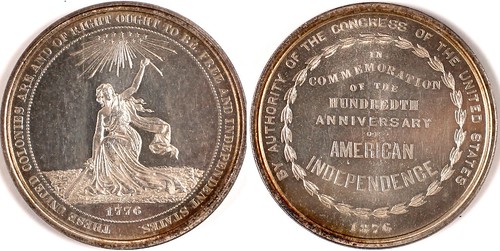
U.S. Centennial Exposition So Called Dollar
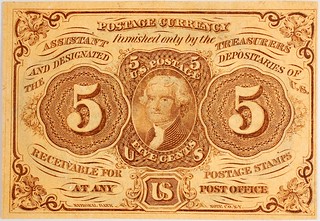
5 Cents First Issue Fractional Currency

San Francisco Clearing House Certificate
For more information, see:
http://holabirdamericana.com/

THE WORTHINGTON TEXAS TOKEN COLLECTION
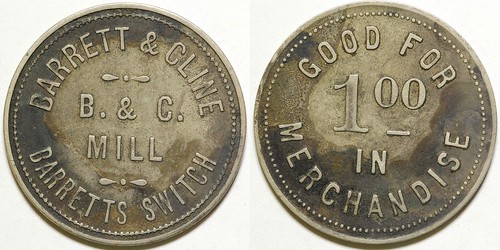
We are pleased to offer the R.B. Worthington Collection of Texas Tokens. R.B. Worthington was the father of R.D. Worthington, the author of the first pamphlet listing of New Mexico trade tokens (1987). This massive collection of about 2000 pieces, will take a number of sales throughout 2018. The Collection will be offered by taking small parts spread out through the collection for each sale, which allows for the offering of both very rare small towns and more common pieces. Some tokens are put into small groups, especially multiple denominations of the same merchant piece.
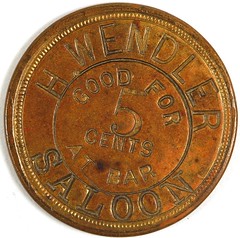 Many of the older collectors knew the Worthingtons. My own introduction to him came through my friend John Schilling, the then head of the Nevada Bureau of Mines. Schilling was the initial cataloger of Nevada trade
tokens, and had an extensive collection that we sold more than twenty years ago. John introduced me to Dick, as well as to Christine and Jack Harkey in New Mexico, who had put together a massive New Mexico Collection, which
we sold about 15 years ago.
Many of the older collectors knew the Worthingtons. My own introduction to him came through my friend John Schilling, the then head of the Nevada Bureau of Mines. Schilling was the initial cataloger of Nevada trade
tokens, and had an extensive collection that we sold more than twenty years ago. John introduced me to Dick, as well as to Christine and Jack Harkey in New Mexico, who had put together a massive New Mexico Collection, which
we sold about 15 years ago.
The Harkeys traded regularly with Worthington. He got all their Texas token, and then the New Mexico. Schilling got the Nevada. The Harkeys spent many hours telling me about their vending machine business in New Mexico
and parts of Texas, which they 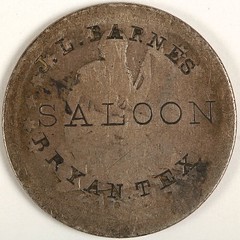 operated approximately c1939-1965 (this is a pure guess- too many years have passed). They pulled out the trade tokens from the machines, and had a heck of a volume of them. I was told many stories of the fun
trading between them and Dick, as well as John. They also collected pennies from the machines, amassing one of the largest hoards of Lincoln cents ever known. They had rolls of everything - including 1909-S VDBs - in
footlockers full dating up to about 1945. Years later, Christine was interviewed for an article in Coin World.
operated approximately c1939-1965 (this is a pure guess- too many years have passed). They pulled out the trade tokens from the machines, and had a heck of a volume of them. I was told many stories of the fun
trading between them and Dick, as well as John. They also collected pennies from the machines, amassing one of the largest hoards of Lincoln cents ever known. They had rolls of everything - including 1909-S VDBs - in
footlockers full dating up to about 1945. Years later, Christine was interviewed for an article in Coin World.
Worthington’s book on new Mexico Tokens is now a rarity. It was succeeded by Schilling’s book, then another by Kaiser.
The listing of Texas Tokens was first done through a series of several long pieces in TAMS Journal circa 1979-1984. Subsequently, our friend Jerry Adams edited a massive private volume on Texas Tokens. Today, Richard Greever heads up the TokenCatalog.com site listing all USA trade tokens. Collectors offer additions to Mr. Greever all the time, and in my own case, Mr. Greever is welcome to any photos or information we publish.
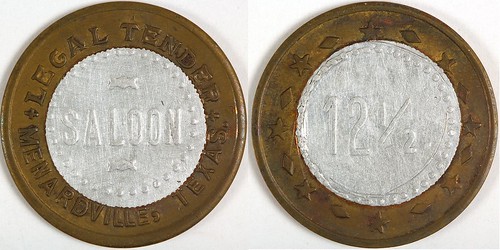
Many of the tokens from the Worthington Collection are unlisted in the initial TAMS volumes, but may be present in the Adams compilation or the Greever online reference. We have tried to note any disparities. There are a large number of Ingle System tokens in the Worthington Collection. If we have not seen that the town is verified, we have done so with Dave Schenkman, who has a copy of the Ingle database. In this light, there are now a number of discoveries that will come out here.
For more information, or to bid, see:
http://bid.holabirdamericana.com/auctionlist.aspx
NUMISMATIC NUGGETS: APRIL 29, 2018
L. Plautius Plancus Silver Denarius

The Roman Republic
L. Plautius Plancus
Silver Denarius, Rome 47 BC.
Obverse: Head of Medusa facing.
Reverse: Victory advancing right, leading four horses by the reins.
Extremely Fine. Spectacular cabinet toning.
4.11g
Crawford 453/1a
To read the complete lot description, see:
L. Plautius Plancus, Silver Denarius (https://www.baldwin.co.uk/l-plautius-plancus-silver-denarius-lm62597.html)
Bruttium, Caulonia. Nomos circa 525-500
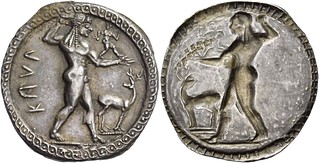
Bruttium, Caulonia. Nomos circa 525-500, AR 7.95 g. KAV? Apollo, diademed, walking r., holding laurel branch in upraised r. hand and small running daimon, holding long branch on outstretched l. arm; in field r., stag r. on platform, with head reverted. Rev. The same type incuse l., without legend. Noe, Caulonia, A 9. SNG Lockett 579 (these dies). Boston 173 (this obverse die). SNG ANS 145 (this obverse die). Historia Numorum Italy 2035. Rare and a superb specimen of this desirable issue. Exceptionally well struck and complete. Superb old cabinet tone and good extremely fine
Ex Gemini V, 2009, 324 and NAC 88, 2015, 358 sales. From the duplicates of the American Numismatic Society (inventory n. 1997.9.212)
The design of the early nomoi of Caulonia has attracted various interpretations, many of which are documented in Barclay Head's Historia Numorum. Head saw the main figure as the mythical founder of Caulonia, who held a leaf from the plant ?a???s as a punning allusion to the city name. Most scholars of the modern era seem to describe the figure as Apollo. The running figure in his hand – whose feet are winged on some examples – is thought by some to be a wind god, perhaps Zephyrus, but it is almost universally described as a genius or a daimon, a deity of a lower order which served the higher gods.
Perhaps the most attractive explanation is that the figure, Apollo, is shown holding a laurel branch from the Vale of Tempe in Thessaly, and that the small figure is a daimon fulfilling the role of his messenger. If so, the type would reflect the story of how Apollo, after killing the serpent Pytho at Delphi with a well-aimed arrow, exiled himself for seven years of menial labour as penance for his murder; at the end of his period of atonement Apollo purified himself in the sacred grove of bay trees. Specifically the type would represent his return to Delphi, announced by the daimon-messenger, to assume his oracular duties on behalf of Zeus.
To read the complete lot description, see:
Lot 161 Bruttium, Caulonia. Nomos circa 525-500, AR 7.95 g.
(https://www.sixbid.com/browse.html?auction=4763&category=140856&lot=3927662)
1691 Ireland Limerick Besieged Halfpenny
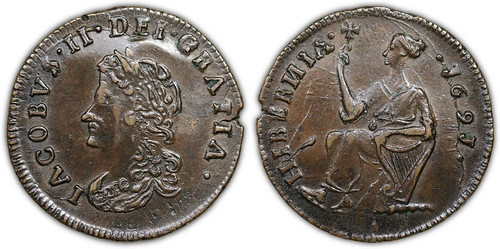
A very high end example of this crude coinage. Struck over gun money, some of the undertype is visible. The “N” in HIBERNIA is backwards, there are die cracks everywhere and the engraving is laughably crude. A fun piece.
To read the complete description, see:
MTG 38: Well Preserved Coins are Little Miracles; Plus - New Purchases
(http://www.davewcoins.com/newsletter/mtg-38-well-preserved-coins-are-little-miracles-plus-new-purchases)
1786 Vermont Landscape Copper
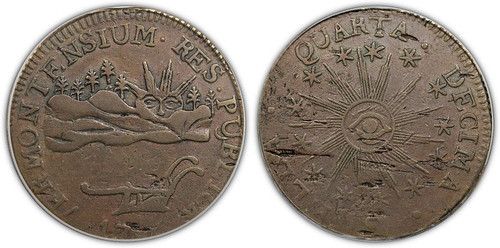
Vermontensium Redbook type. Ryder-6. A lovely milk chocolate brown coin, with hard surfaces. These are so difficult to find that are pleasing to the eye, as here. There are always – always – issues that collectors have to deal with; it is just a matter of finding a specimen where the issues are not bothersome.
To read the complete description, see:
MTG 38: Well Preserved Coins are Little Miracles; Plus - New Purchases
(http://www.davewcoins.com/newsletter/mtg-38-well-preserved-coins-are-little-miracles-plus-new-purchases)
India Superannuation Medal
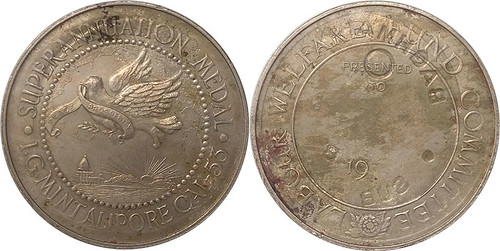
India Government Mint Medal, Nickel, 31.68 g, 38.44 mm, Superannuation Medal Kolkata Mint, Obv : Dove holding and ribbon with words Peace Prosperity, scenery behind, Legends around SUPERANNUATION MEDAL I.G.MINT ALIPORE CAL-53. Rev : Legends LABOUR WELFARE FUND COMMITTEE, Unpresented, Traces of other medal strike seen on reverse. Extremely Fine, Extremely Rare.
To read the complete lot description, see:
India Government Mint Medal
(http://www.imperialauctions.com/view-lot.aspx?lid=9820&aid=15&cid=0&key=0&mid=0&lfr=0<o=0&pfr=0&pft=0&ino=0&pno=1)

ANCIENT COINAGE OF ARMENIA
PEOPLE SPEAKING ARMENIAN (AN INDO-EUROPEAN language) have inhabited lands between the Caucasus and central Anatolia for many, many centuries. The earliest record of the name “Armenia” appears in the Behistun Inscription, carved on a rock cliff in western Iran for the Persian ruler Darius the Great around 520 BCE.
Soon after the invention of coinage (seventh century BCE), Greek and Persian coins reached Armenia in trade, but apparently the first coins issued by Armenian rulers were struck for kings of Sophene (now part of southeastern Turkey) in the third century BCE. These bronze pieces were in denominations of four, two and one chalkoi (the chalkous was a unit of about three grams). The ruler’s name and titles were inscribed in Greek letters, but the blanks were often too small for the dies.
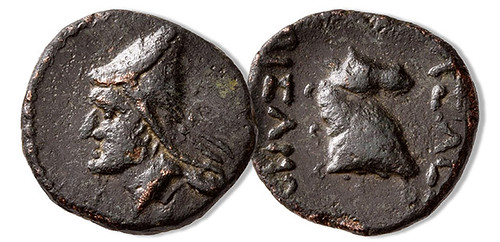
KINGS OF SOPHENE. Arsames I, circa 240 BC. Chalkous (Bronze, 16 mm, 2.88 g, 11 h). Head of Arsames I wearing tiara to left. Rev. [B]ASI?E[OS] – APSAMO[Y] Head of a horse to right. Bedoukian, Coinage -. Nercessian CA -. Cf. Lanz 160 (2015), 253 and Gorny & Mosch 220 (2014), 1452. Very rare. Well struck and with an exceptionally sharp and attractive portrait. Leu Numismatik Auction 1. 25 October 2017. Lot : 97.
To read the complete article, see:
CoinWeek Ancient Coin Series: Ancient Coinage of Armenia
(https://coinweek.com/ancient-coins/coinweek-ancient-coin-series-ancient-coinage-of-armenia/)
MAXENTIUS, FIGHTER FOR ROME
The year 307 was one of the most eventful in the history of the tetrarchy. A golden medallion, offered by Hess-Divo at auction 334, refers to this history. On it, Maxentius is being celebrated as defender of Rome.
It was an eventful year, the year AD 307, when the quadruple gold coin bearing the portrait of Maxentius was minted in Carthage. Hess-Divo offer it at their auction 334.
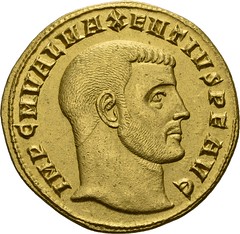
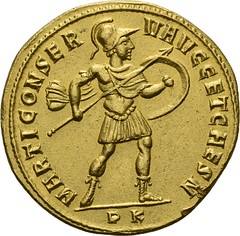
01 – Maxentius, 306-312. Quaternion (4 aurei), Carthage, 307. Spectacular unique from the Partinico hoard of the late 50s. From Hess-Divo auction 334 (May 29 th , 2018), no. 135. Extremely fine. Est.: CHF 100,000.
On the back, it shows Mars Conservator, Mars the preserver. Now, the Roman god Mars must under no circumstance be confused with his Greek equivalent, the “man-slaughtering Ares”, as he is referred to in the Iliad. Mars is the god of war who supports those defending their home. Mars fights with all the virtues that characterize a true man – with courage, devoutness and reverence for traditions. Mars is the incarnation of righteous war, which the Romans claimed for themselves.
Maxentius did not chose this image randomly. On the contrary, he used it to set himself apart from his competitors and to proclaim a political program. Which was that? In order to understand that, we need to return to the eventful year of 307.

02 – The starting point in AD 305: The partitioning of the Roman Empire under Diocletian. Hellerick / Wikipedia, cc-by 4.0.
At the time, many were struggling for power over the Roman Empire. Diocletian had abdicated on May 1 st in 305 and appointed his successors. Constantius Chlorus was to be in control of the West with the support of Severus, and Galerius of the East, together with Maximinus Daia. Thus, not only Diocletian’s colleague Maximianus Herculius fell short, who grudgingly accepted his abdication, but above all the sons of Constantius Chlorus and Maximianus Herculius. Diocletian, who had no children, had misjudged the situation and passed over their entitlements.
We are not going to retrace all the battles and political dodges that led to these very sons, Constantine I and Maxentius, becoming essential factors of power. Let us jump right into the year 307. At this point, Constantine I had already been established as ruler over Gaul, Spain and Britain. Maxentius was domiciled in Rome. He had taken advantage of the fact that Galerius tried to abolish the tax exemption of the Roman population. It was foolish of Galerius to simultaneously announce that the Praetorians were supposed to give up their comfortable garrison in Rome in order to serve at the front. Citizens and soldiers together called Maxentius for help – an act that Galerius would not tolerate. He ordered Severus to solve the problem.
But Maxentius had a trump card: his father Maximianus Herculius, who was sulking in Lucania. When his son sent the message saying he needed him, Maximian instantly rushed to Rome, eager to once more pull the strings of international politics. Maxentius had hoped that his father was still more popular with the army than Galerius or Severus, which was indeed the case. But Maximian wanted to be emperor himself again. And thus, after his arrival in Rome, he simply pushed Maxentius aside and, in February 307, had himself once more be pronounced Augustus by the people and the senate.
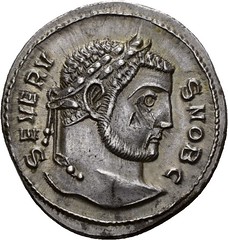
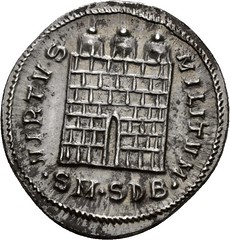
03 - Severus. Argenteus, Serdica, 305-306. From Hess-Divo auction 334 (May 29 th , 2018), no. 134. Extremely fine. Est.: CHF 3,500.
Maximian’s first task was to defend the city against Severus. But there wasn’t much defending to do. Under Maximian, the soldiers had fought for almost 20 years, under Severus, not even two. As soon as they saw their former commander, the soldiers defected to him in droves. Severus had to flee from his own army to Ravenna, where he surrendered to Maximian. After this victory, Maximian was entirely in his element. His former power was back within reach. All he needed was an ally, and who would have been a better candidate than Constantine, his old wartime comrade’s son?
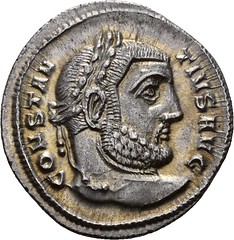

04 - Constantine I. Argenteus, Serdica, 305-306. From Hess-Divo auction 334 (May 29 th , 2018), no. 133. Extremely fine. Est.: CHF 750.
So, Maximian left business in Rome to his son Maxentius and rushed to Treves. There, the old emperor offered the young man to officially recognize him as Augustus and to adopt him. He should also marry Maximian’s daughter. In return, Maximian hoped to get military support and a clear political positioning against Galerius. But Constantine was much too smart for that. He made Maximian wait, let the statues of Severus – who in the meantime had died anyway – be canted over, and did nothing else which could have been interpreted as explicitly taking sides against Galerius. Maximian returned to Rome without having achieved anything, where he was surprised to find that, by now, the city was in his own son’s hands. For Maxentius had succeeded, all by himself, to prevent Rome from being attacked by an army led by Galerius. Galerius too had lost soldiers who had gone over to serve the son of Maximian.
Now Maxentius had the Roman senate give him the title of Augustus and officially took over the rule in the territory of late Severus. The magnificent gold medallion is likely to have been minted in celebration of his accession to power as Augustus. With it, Maxentius underlines that he is willing and able, with the help of Mars and the associated virtues, to defend the old capital Rome against all attacks, as had done all rightful emperors before him. Thus, he positions himself against Galerius, who had tried not only to take privileges away from the Eternal City, but even to lead an army against the old capital. This way, Maxentius claims to be the true defender of the Roman idea. At the same time, he had coins minted for Senior Augustus Maximian and Caesar Constantine.
So, Galerius saw an opposing front building up against him which to counter by himself he did not feel strong enough. He had to do something to reinforce his fading influence, and only one person came to his mind: His old supporter Diocletian should once more, with all his authority, mediate between the disputing parties. He did, only nobody listened to his suggested compromise. The fight for the Roman Empire entered the next round.
The online catalog is available here: https://www.sixbid.com/browse.html?auction=4833

WAYNE'S NUMISMATIC DIARY: APRIL 29, 2018
Last week was a treat for me - visiting downtown Chicago for the first time. I've been to every other major U.S. city, but by happenstance never made it to the heart of the Windy City for either business or pleasure. While I have been to the American Numismatic society and Central States shows, those were out on Rosemont by the O'Hare airport, an hour away.
My purpose was to visit the Chicago Coin Expo and discuss the newman Numismatic Portal. I also saw some E-Sylum contributors and supporters.
To take full advantage of my first-time visit I booked an extra day's stay and took my son Christopher with me - he'd never been there either. Here's a photo gallery including some city sights, numismatic personalities and some numismatic-related sculpture.
The Palmer House
We took the train from O'Hare airport and walked about a block to our hotel, the Palmer House. It's a large, classic formal hotel with a marvelous lobby.
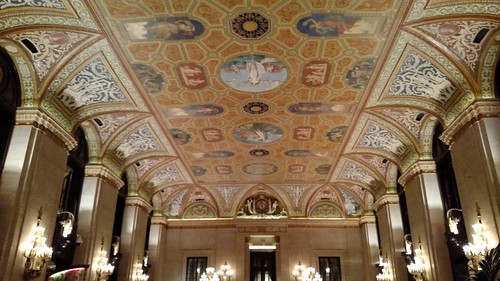
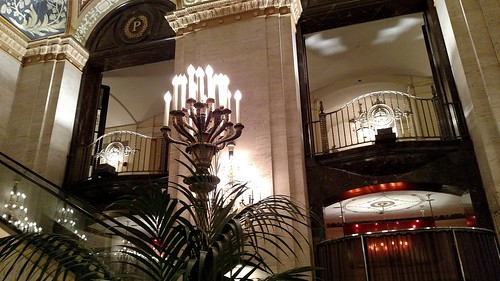
I wondered where a spare door in our room went, so I tried the knob. When it opened, I got a very creepy "Tower of Terror" vibe seeing this abandoned bathroom with an inch of dust bunnies on the floor. I think I heard the Twilight Zone theme. I couldn't resist texting the photos to my wife who asked, "WHY ARE YOU STAYING THERE???" Actually, the working bathroom and the rest of our room were just fine and quite nice.
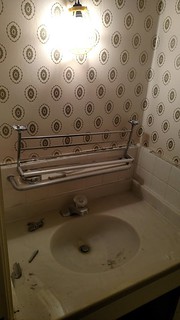
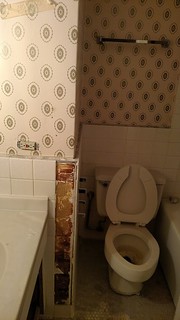
Chicago Sights
Chris and I walked around downtown for a bit to find a place for lunch (deep-dish pizza, of course), then headed toward the Navy Pier for a river cruise tour of Chicago architecture. It was an enjoyable afternoon. Before my
phone battery died I took some pictures.
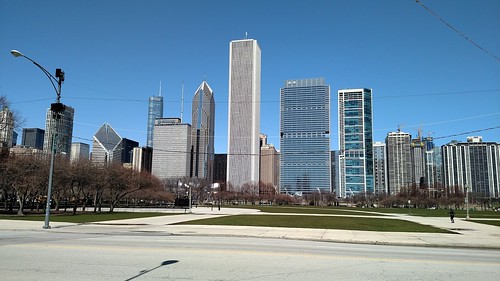
The Chicago Coin Expo
After breakfast Friday I went to the show. One of the first people I spoke to was numismatic bibliophile Bill Burd, who'd brought a selection of world gold for sale.
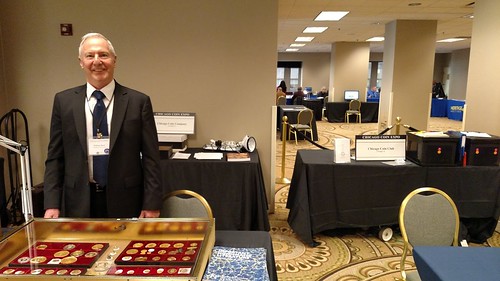

Next to Bill's table was the Chicago Coin Club. Manned by Bob Leonard, Steve Zitowsky and Carl Wolf.
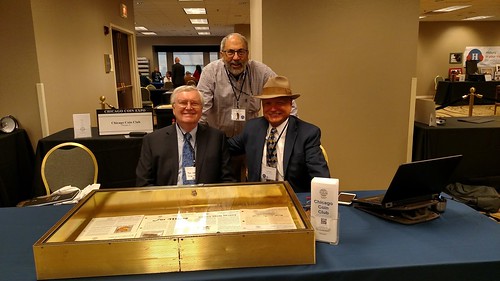

Bob Leonard showed me a book on Myanmar currency and Carl had a chat with Kyle Ponterio.
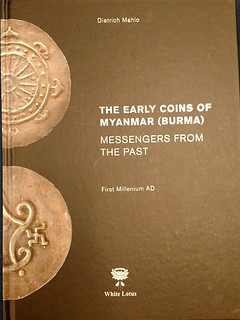
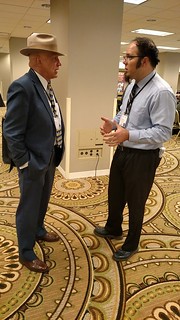
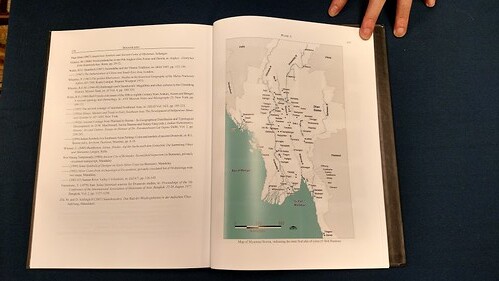
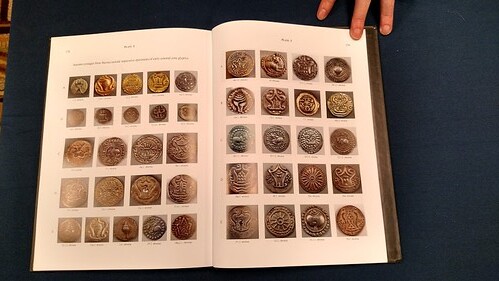
Here's E-Sylum supporter Jeremy Bostwick of Numismagram with a nice selection of medals.
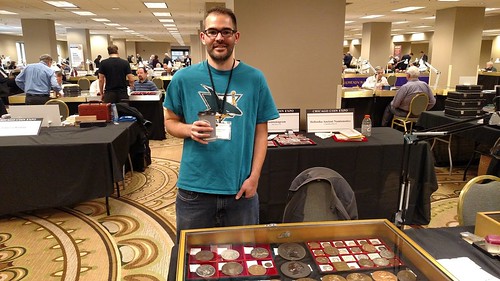
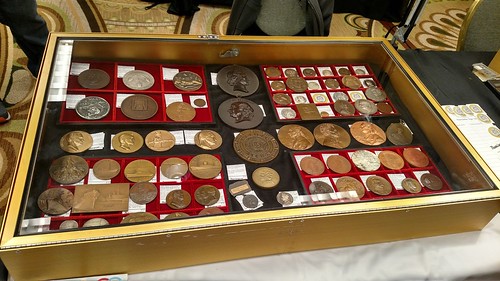
Next up was E-Sylum supporter Shanna Schmidt with her Mom Ellen. we had a nice chat about numismatics, coin shows, and the magic power of M&Ms as a table draw.
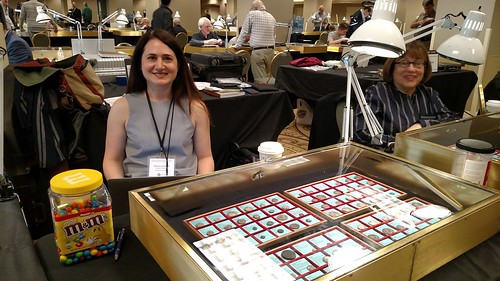
I shouldn't have been surprised to see Tony Terranova - he's everywhere!
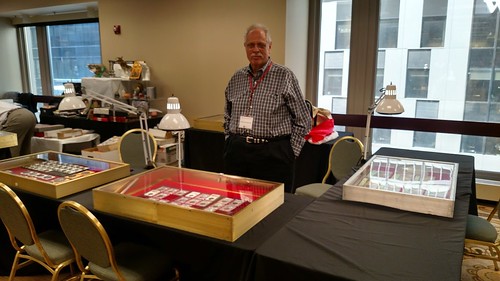
The Art Institute of Chicago
After lunch Christopher and I visited the Art Institute, a convenient two-block walk from the Palmer House. Here's an 1834 painting "Pergola with Oranges" by Thomas Fearnley.

Eveyone loves the Impressionists and I'm no different. But nothing prepared me for Room 243. My jaw immediately dropped on entering the room and it stayed dropped until we left. The room was filled with Monets, including not one but a series of four Haystack paintings. It felt like the most beautiful room I'd ever entered, like I'd died and gone to heaven. That room alone was worth the price of admission.
I have a soft spot for another Impressionist though, American Mary Cassatt. She was born in my hometown of Pittsburgh, and I've owned at least half a shelf of books on Cassatt and her works. Here are two paintings we saw in Chicago.
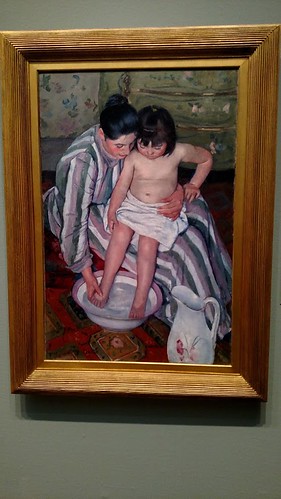
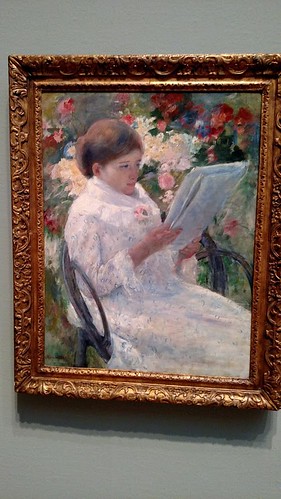
I was on the lookout for artworks associated with numismatics. Here are a few that caught my eye.
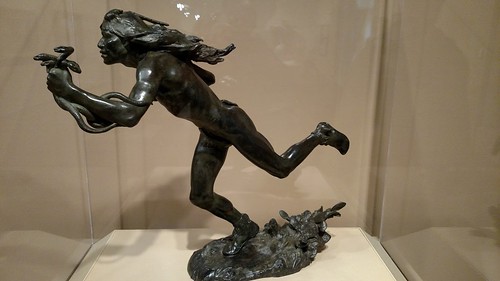
by Harmon McNeil, Standing Liberty Quarter designer
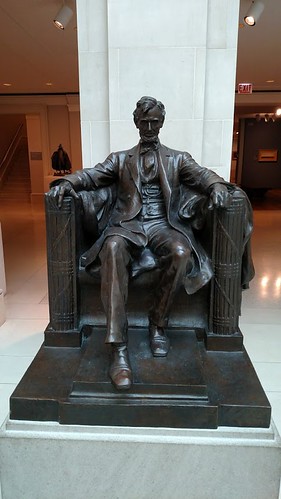
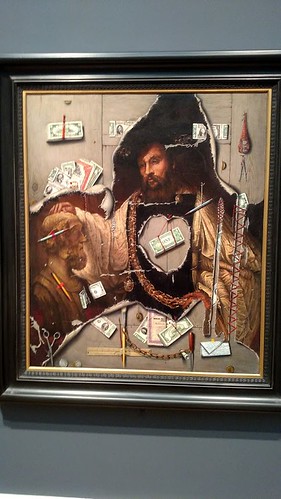
Left: Daniel Chester French, Abraham Lincoln
Right: Otis Kaye, Heart of the Matter
The French statue is a scaled copy of the one in the Lincoln Memorial (pictured on the reverse of the Lincoln Memorial cent). Otis Kaye was one of the trompe l'oeil artists frowned upon by the U.S. Secret Service for painting realistic images of paper money.
It was a great trip and I'll look forward to another visit. I hope all of our readers consider planning to attend the 2019 American Numismatic Association World's Fair of Money in sort-of-nearby Rosemont, IL.
THE BOOK BAZARRE
MORE ON THE NEW EFFIGY OF QUEEN ELIZABETH II
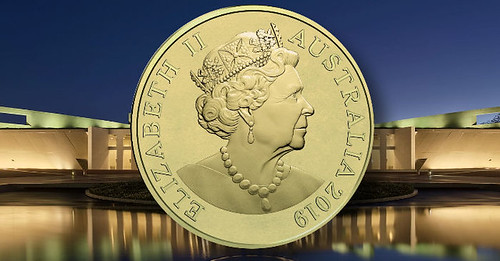
The federal government and treasury of Australia announced (22nd April) that Australian circulation coins will undergo a new design when the Queen’s effigy will be replaced with an updated likeness. The current effigy was created by British sculptor Ian Rank-Broadley and was first introduced in 1998 on British coinage and subsequently on Australian coins a year later. The new effigy chosen was designed by Royal Mint sculptor Jody Clark and first used on the coins of the Isle of Man in 2017. The Queen is shown wearing the Royal Diadem, which she wore during her coronation, and, according to tradition, the Queen will continue to face to the right on the coin. The design change was announced one day after the Queen celebrated her 92nd birthday.
To read the complete article, see:
Australia announces new effigy of Queen Elizabeth II for circulation coins
(http://news.coinupdate.com/australia-announces-new-effigy-of-queen-elizabeth-ii-for-circulation-coins/)
SOUTH AFRICA MINTS LATENT IMAGE MANDELA COIN
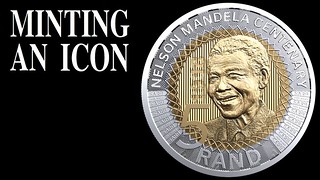 The R5 coin is the first latent image circulation coin to be issued in South Africa. The latent image features the years 1918 and 2018, and will display distinct images, depending on the viewing angle. These
include the R5 denomination; the words ‘Nelson Mandela Centenary’; and the image of a smiling and mature Mandela against a background of rich patterning.
The R5 coin is the first latent image circulation coin to be issued in South Africa. The latent image features the years 1918 and 2018, and will display distinct images, depending on the viewing angle. These
include the R5 denomination; the words ‘Nelson Mandela Centenary’; and the image of a smiling and mature Mandela against a background of rich patterning.
“It’s one of the most beautiful circulation coins that we have manufactured,” notes head of product development Richard Stone.
This image was specifically chosen to complement the last two R5 circulation coins issued in 2000 after Mandela’s Presidential term and in 2008 following his ninetieth birthday.
“We commissioned Sindiso Nyoni, a seasoned portrait artist, whom we have collaborated with before, to design the OR Tambo as well as these Mandela centenary coins. Sindiso is an exceptional artist who has had international success in Europe and Mexico.”
Previously, the mint followed a fixed design process whereby a model was based on a sketch from a photograph. However, with the OR Tambo coin, the mint decided to take a new approach based on Nyoni’s style, which is an abstract interpretation.
“Even though there’s a high degree of abstraction, the images are still recognisable. It helped us to approach the design in a new way. “The OR Tambo coins are faceted and, if you move it slightly, the picture changes. The coins are designed in base relief. We issued four coins in the first series: a collectable copper coin, a 1 oz sterling silver coin and a 1 oz, 24 ct gold coin.”
The mint used laser engraving technology to design the coins; the aluminium bronze coin was first introduced as a collectable coin with the Tambo centenary range in 2017.
“We don’t typically manufacture a coin in that medium; we usually use gold and silver for collector coins. Last year was the first time we made collectable base metal coins, starting with the OR Tambo coin. We are increasingly doing more new things. There has been significant innovation in the technology we use,” he says.
The mint, with almost 500 employees, has a production capacity of some two-billion coins, ranging from circulation coins to the highest quality possible for collector coins.
The South African mint today comprises three business units: Circulation Coins, Collectable Coins and Bullion (the Krugerrand), which is part-owned by Rand Refinery.
The mint produces circulation coins for export markets mainly in the Africa, South America and Asia. The Circulation Coins division manufactures the legal tender coins that are used by South Africans for everyday transactions, as well as coin blanks and circulation coins for the export market.
Over the years, the mint has developed expertise in producing electroplated base metal coins which are the most cost-effective means for central banks and issuing authorities to place coins into circulation.
To read the complete article, see:
New technology being used to immortalise Mandela in centenary coins
(http://www.engineeringnews.co.za/article/new-technology-being-used-to-immortalise-mandela-in-centenary-coins-2018-04-27)
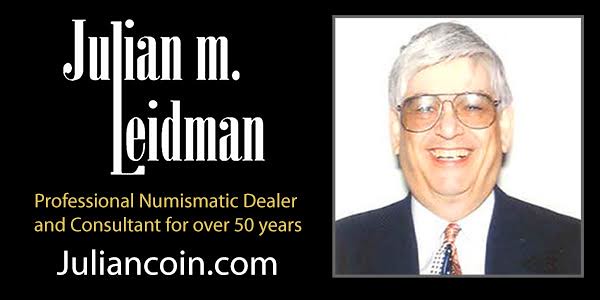
FAKE COUNTERFEITING NEWS AFFECTS INDIAN COINS
 Many people in India wrongly believe their 10-rupee coins are worthless, after reports of widespread counterfeiting went viral on social media. The coins are real. The news is fake.
Many people in India wrongly believe their 10-rupee coins are worthless, after reports of widespread counterfeiting went viral on social media. The coins are real. The news is fake.
Across India, where 10 rupees - about 15 U.S. cents - can buy a meal, people are stuck with money they can't spend because no one will take it.
The problem stems from the large variety of 10-rupee coins in circulation. More than 5 billion coins, worth over $775 million, have been minted since 2010.
With 14 versions of the coin, including one marking Yoga Day, confusion has spread and reports that claimed to tell people ho to spot fakes proliferated.
As the fake news spread, coins have piled up across India, and merchants don't know what to do.
The central bank has tried to turn things around, sending hundreds of millions of text messages, in 13 languages: "Accept them without fear."
In some areas the coins simply aren't being used anymore as people have given up on trying to figure out what to believe.
To read the complete article, see:
The Money Nobody Wants (http://www.wsj.com/graphics/india-money-crisis-is-fake-news/)
For more information on the coins, see:
Indian 10-rupee coin (https://en.wikipedia.org/wiki/Indian_10-rupee_coin)
CIVILIAN CONSERVATION CORP CAMP TOKENS
I reached out to Paul and Talkin’ Tokens editor Jeff Smurthwaite for permission to excerpt the text of the article here. Images are from Richard Greever's Token Catalog. Thanks to all for their assistance with this. -Editor
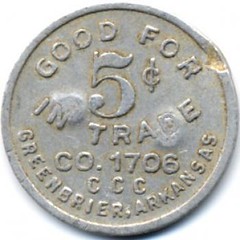
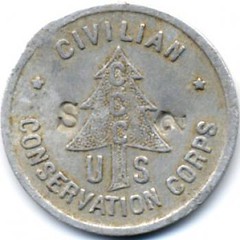
5 Cents CCC Token Greenbriar, AR
The CCC was created as a "workfare" organization to provide employment opportunities to 18-25 year old youth. The pay was set at $25 per month for basic enrollees, with most of that pay (generally $20 per month) sent back to parents or guardians of the enrolled youth. This provided much needed assistance to many families that were too proud to receive public assistance, and put otherwise unemployed youth to productive use in improving our natural resources.
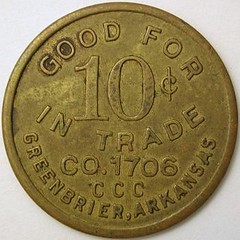
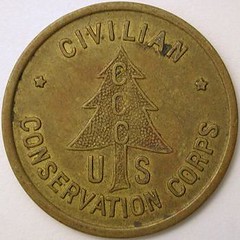
10 Cents CCC Token Greenbriar, AR
The CCC reached a maximum enrollment of 500,000 by 1937, thus giving many a way out of the cycle of poverty created by the great depression of the 1930's. It was disbanded on June 30, 1942, seven months after the United states entered World War II.
In Michigan, The CCC operated over 100 camps, and is said to have planted over 485,000 trees, mostly in the northern two-thirds of the state. The CCC Museum at North Higgins Lake State Park, opens to the public from the Memorial Day weekend through Labor Day weekend, is a tremendous source of information for those interested in the history of the CCC in Michigan. Interestingly enough, the only known Michigan CCC tokens are from Company 672 at Camp Higgins Lake, 4 miles west of Roscommon, the current location of the CCC Museum!
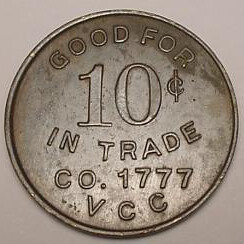
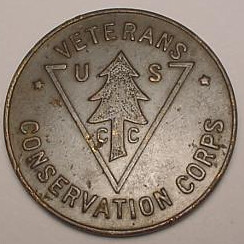
10 Cents VCC Token Atlantic, IA
In addition to the youth enrolled In the CCC, there was also a Veterans Conservation Corp~ (VCC), which comprised approximately 10% of the total enrollment in the CCC. The vast majority of the enrollees in the VCC were were World War I veterans. The pay for the veterans conservation Corps was about the same as what they made in the military, about a dollar a day, but in the veterans Conservation Corps they had to endure a lot less. Trench foot, cooties, mustard gas, and machine gun fire were not a part of the VCC job description. Work for the veterans included plant1ng trees, soil conservation work, building of state parks, development of the national forests, and a host of other services.
CCC camp tokens were generally issued in 5¢ and 10¢ denominations due to the limited amount of spending money (generally $5.00 per month) allotted to the enrollees. About 1/4 of the tokens issued were of the "Tree" type, an attractive stock reverse,with some of these being issued for the Veterans Conservation Corps. The balance of the tokens known come from various makers, including a number of E.A. Schmidt issued tokens, as well as those of other makers.
Most of the known tokens are scarce to rare, with only a handful of tokens within the series that could be considered common. Many coupon books were also issued by the CCC camps, but the decision was made not to list them in the present article. The present listings include only metal &. fiber tokens.
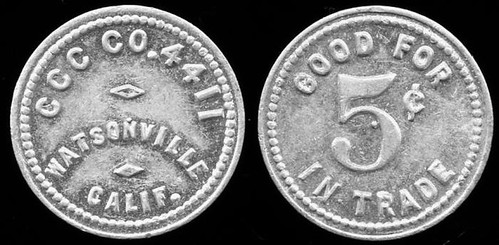
5 Cents CCC Token Watsonville, CA
Paul Manderscheid adds:
I have found perhaps 20 or 30 new listings since the 2010 revision. I still have my collection of these, numbering about 205 varieties, which I’ve put together over the last 30 years.
CCC Camp Exchange Coupons
Ken Berger writes:
My father (Edward Berger) was in the Civilian Conservation Corps from 1939-1940. Attached are some scans of numismatic-related items during his time in the CCC.
An interesting side note is that these contain one of the few examples of my father's original signature. During the Battle of the Bulge he was wounded and the median nerve in his right arm was destroyed and had to be removed. As such, he had to relearn how to write using his left hand. The best he was ever able to do was sign his name and print in block letters.
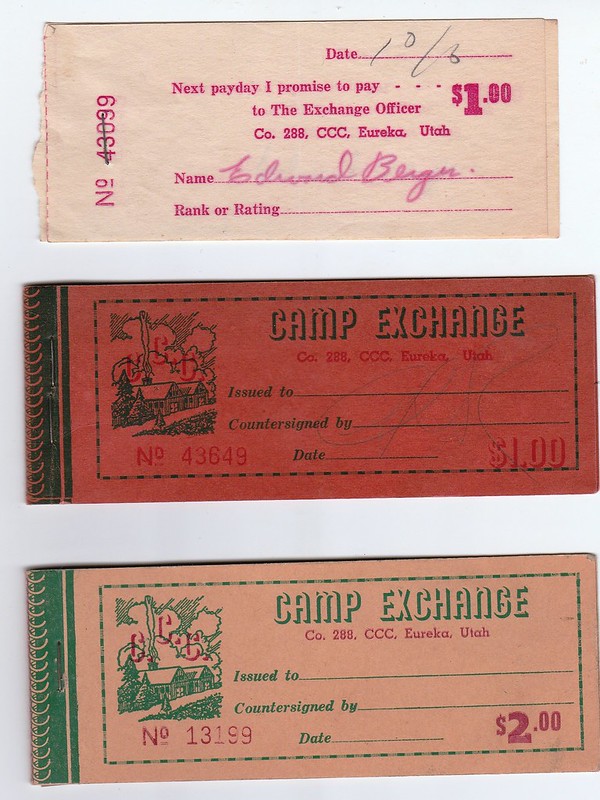
For the complete TokenCatalog entries, see:
10 Cents CCC Token Greenbriar, AR
(http://tokencatalog.com/token_record_forms.php?
action=DisplayTokenRecord&td_id=219171&inventory_id=165191&td_image_id=93157
&attribution_id=222691&record_offset=11)
5 Cents CCC Token Greenbriar, AR
(http://tokencatalog.com/token_record_forms.php?
action=DisplayTokenRecord&td_id=255787&inventory_id=208750&td_image_id=114685
&attribution_id=260645&record_offset=12)
5 Cents CCC Token Watsonville, CA
(http://tokencatalog.com/token_record_forms.php?
action=DisplayTokenRecord&td_id=446803&inventory_id=474344&td_image_id=301919
&attribution_id=459256&record_offset=25)
10 Cents VCC Token Atlantic, IA
(http://tokencatalog.com/token_record_forms.php?
action=DisplayTokenRecord&td_id=188770&inventory_id=128261&td_image_id=72823
&attribution_id=191740&record_offset=0)
For more information on the Civilian Conservation Corps, see:
Civilian Conservation Corps (https://en.wikipedia.org/wiki/Civilian_Conservation_Corps)
To read the earlier E-Sylum article, see:
NUMISMATIC NUGGETS: APRIL 22, 2018 : Civilian Conservation Corps. Token (http://www.coinbooks.org/v21/esylum_v21n16a35.html)
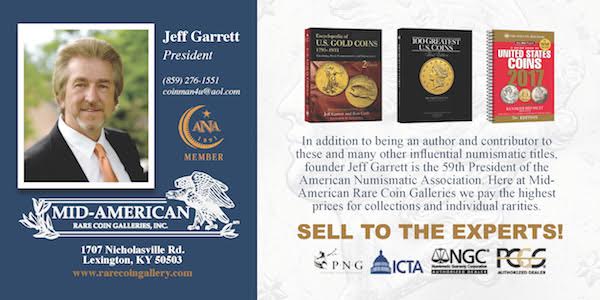
SAWYER’S NATIVE AMERICANS MEDALS INFO SOUGHT
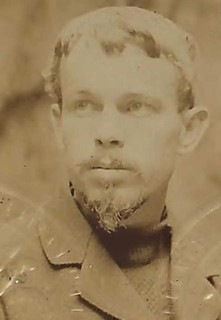 Edward Warren Sawyer (1876-1932) was a little-known sculptor who was trained at the Art Institute of Chicago. He made three trips to the west in 1904, 1908, and 1912. His first trip in 1904 was to Yuma and Ganado,
Arizona where he lived and worked with members of the Yuma and Navajo Nations. Four years later, Sawyer traveled to Agua Caliente, Arizona and resided at the Apache Nation. His final trip was extensive, finding him in
Oklahoma, South Dakota, and Montana.
Edward Warren Sawyer (1876-1932) was a little-known sculptor who was trained at the Art Institute of Chicago. He made three trips to the west in 1904, 1908, and 1912. His first trip in 1904 was to Yuma and Ganado,
Arizona where he lived and worked with members of the Yuma and Navajo Nations. Four years later, Sawyer traveled to Agua Caliente, Arizona and resided at the Apache Nation. His final trip was extensive, finding him in
Oklahoma, South Dakota, and Montana.
Sawyer created clay models and plaster casts of a number of Native Americans on these trips. My research has found nine different subjects from his 1904 excursion, three from his 1908 trip, and 26 from his 1912 venture. Three of his models are known in two different versions, for a total of 41 varieties.
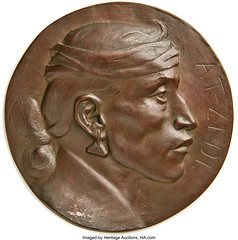
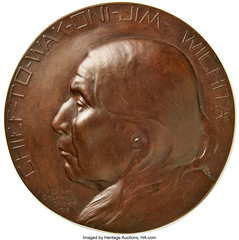
Many of Sawyer’s subjects were obscure, although some are well-known to history students today. One of those was Curley (or Curly), a member of the Crow tribe in Montana who worked as a scout for George Armstrong Custer and who was the only survivor of Custer’s battalion at the Battle of Little Big Horn. A Google search for “Curly Custer Scout” will provide considerable biographical information.
The Medallic Art Company created bronze galvanos from Sawyers plaster casts soon after each of his visits. A galvano is a metallic shell that is one sided. The back is typically filled with lead or some other material to provide strength to the shell.


Surviving examples are extremely rare and almost exclusively found in museums, and no single complete collection exists. The American Numismatic Society has 37 examples, the Art Institute of Chicago has 35, the Smithsonian Institution has 32, the Massachusetts Historical Society has 31 examples, and the University of Reno has 31 examples. All of those are 2-3/4 inches in diameter with nine additional examples in a private California collection, five at the Musée d’Orsay in Paris, France, and two sold by Bonham’s in June 2017 as previously reported in The E-Sylum.
A small number of five-inch diameter galvanos were also produced, and the Whitney Western Art Museum at the Buffalo Bill Center of the West in Cody, Wyoming has 23 of the larger diameter galvanos. A wonderful collection of 18 additional large size examples from a private collection will appear in the Heritage Auctions June 2018 Long Beach sale, and those are the only large diameter pieces known to me outside of museums.
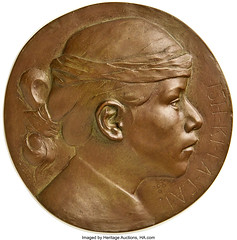
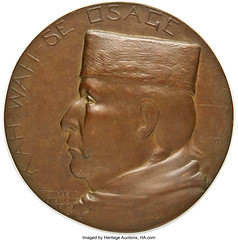
I am working with Medallic Art Company historian Dick Johnson and former Salmagundi Art Club head curator Robert Mueller to publish an in-depth article and census of the 41 varieties. We have currently located 226 examples in the two different sizes and would like to hear from anyone who has knowledge of others at MarkB@HA.com.
To read the earlier E-Sylum articles, see:
ANS PUBLISHES EDWARD SAWYER’S NATIVE AMERICANS MEDALS ONLINE (http://www.coinbooks.org/esylum_v16n46a12.html)
MORE ON EDWARD SAWYER'S INDIAN MEDALS (http://www.coinbooks.org/esylum_v16n47a16.html)
SAWYER NATIVE AMERICANS MEDAL GALVANOS (http://www.coinbooks.org/v20/esylum_v20n22a26.html)
MOTHER AND DAUGHTER AT ODDS OVER HERO'S MEDALS
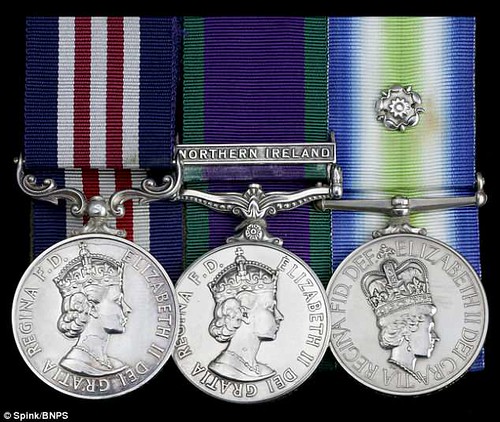
She was only four when her hero father was killed in the Battle of Goose Green in the Falklands.
Paratrooper Gary Bingley was shot as he stormed an Argentine machine gun nest in an act of bravery described as ‘instrumental in defeating the enemy’.
Zoe McKay was too young to understand when her mother Jayne proudly showed her his Military Medal after collecting it from the Queen at Buckingham Palace. Now mother and daughter are at war over the sale of the medals, which are due to go under the hammer at London auction house Spink and Son today.
Last night heartbroken Zoe McKay – who is estranged from her mother – made a final plea to keep the medals in the family.
She is desperately trying to raise £70,000 to buy them herself after her mother, now called Jay Hyrons, 60, decided to part with them to fund her battle with ill health. Her daughter said: ‘My dad gave his life and the medals should remain part of his family.
To read the complete article, see:
Family at war over Paratrooper's medals: Daughter tries to raise £70,000 in fight to stop mother
selling hero's Falklands honours (http://www.dailymail.co.uk/news/article-5651719/Falklands-hero-daughter-makes-desperate-bid-buy-medals.html)

IRANIAN PROTESTERS SPREAD MESSAGE ON BANKNOTES
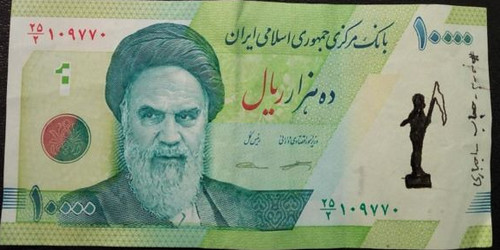
A group of Iranian Twitter users are spreading protest messages by writing slogans on banknotes.
"Banknotes are our un-censorable messengers," one user wrote, referring to a rumoured plan to permanently block the popular messaging app Telegram, which is by far the most popular digital communication tool in Iran.
Slogans included "I am an overthrower".
Some of the sayings were originally chanted during mass anti-establishment protests at the turn of the year.
In late December, demonstrators took to the streets then to express their dissatisfaction with the social and economic situation in the country.
To read the complete article, see:
Iranians launch banknote protest to get round censorship (http://www.bbc.com/news/world-middle-east-43942604)
COMMUNITY CURRENCY: LAKE DISTRICT POUND
 The Lake District Pound (LD£) is our region’s new local currency – designed to celebrate everything you love about this place, and help keep our region special.
The Lake District Pound (LD£) is our region’s new local currency – designed to celebrate everything you love about this place, and help keep our region special.
From 1st May 2018, you’ll be able to spend LD£ in local businesses in and around the Lake District, where you see the LD£ sign.
Spending LD£ is a great way to explore our local culture and show your support for the local businesses that make it so special. Only local businesses can accept the LD£, so you know you’re supporting our communities. Every LD£ makes a difference.
The Lake District Pound is an annual currency – with exciting new designs launching each year. You can buy LD£ online, or at LD£ Exchange Points throughout the Lake District. There are no charges or exchange rates to pay, and you can always swap back any currency you’re not able to spend during its period of validity.
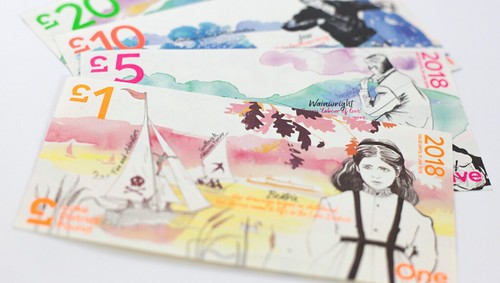
If you pick up a LD£ Passport, you can collect stamps when you visit local businesses on the LD£ Passport Trail. There are loads of fun icons to collect, and every stamp is unique.
Every LD£ you collect as a memento (instead of spending it) goes straight towards projects that look after the Lake District’s landscapes and communities. All proceeds are shared between Cumbria Community Foundation and the Lake District Foundation.
For more information on the Lake District Pound, see:
https://www.lakedistrictpound.com/
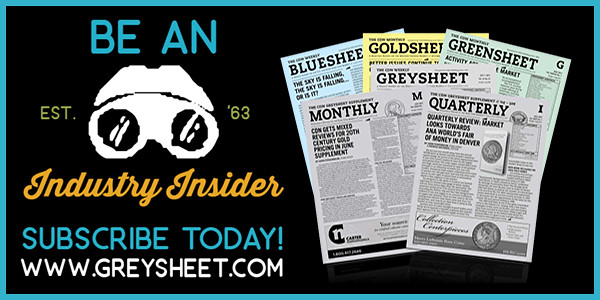
IN OTHER NEWS: APRIL 29, 2018
Harvey Stack on U.S. Mint Surcharges
I just saw the April 3 edition of Numismatic News and read with great excitement the question you asked: “Coin Surcharges or No Surcharges?”
The question was asked many times before. We both remember the series of commemorative coins issued from 1982 to 1999, each of which had large premiums attached to them.
By 1995, the premiums absorbed all the gains that people had invested in, and many of the new issues resulted in dropping in price to half their original cost on the numismatic market.
Having a retail shop, we experienced such dismay when one came in to sell these and we as dealers were accused of grossly underpaying for these coins.
To read the complete article, see:
Viewpoint: Leave some profit for the little guy (http://www.numismaticnews.net/article/viewpoint-leave-profit-little-guy)
About Lists on the Internet
Lists are finite. Comment sections are not.
The list you’re looking at? The author missed some books that could have fit. Guess what? She knows. I promise you, she knows. Every book cannot be on every list. If you feel the urge to comment on a listicle (or god forbid,
email the author) with something like “I CAN’T BELIEVE YOU MISSED/FORGOT/HATE BOOK X,” or “I can’t respect/won’t read/don’t trust a list that doesn’t include book y,” try instead saying “Hi! Loved this list. I’d add books x,
y, and z. Have you read them?” Why have an angry response instead of a creative (or hey, even constructive) one? (By the way, I have gotten the latter type of message, just not nearly as often as the former.)
Life is short. Death is certain.
Why are you angry at the internet?
To read the complete article, see:
10 THINGS YOU SHOULD KNOW ABOUT LISTS ON THE INTERNET (https://lithub.com/10-things-you-should-know-about-lists-on-the-internet/)
Three New Books About Libraries
Three new books for bibliophiles dig into the hidden human side of book collections.
Libraries, writes Stuart Kells, a historian of the book trade, are “human places … full of stories.” Kells’s new book, The Library: A Catalogue of Wonders, offers a history that begins before the written word and follows the development of book collections through the digital age.
To read the complete article, see:
Every Library Has a Story to Tell (https://www.atlasobscura.com/articles/books-about-libraries-history)
More-Or-less Facts About U.S. Paper Currency
 #5. The Bureau of Engraving and Printing uses 9.7 tons of ink each day — This is from the combined use of its two facilities – one in Washington, D.C. and the other in Fort Worth, Texas.
#5. The Bureau of Engraving and Printing uses 9.7 tons of ink each day — This is from the combined use of its two facilities – one in Washington, D.C. and the other in Fort Worth, Texas.
To read the complete article, see:
8 Fascinating Facts About Our Nation’s Currency! (http://www.budgetsaresexy.com/united-states-paper-money-facts/)

